Hours: Thurs-Mon, noon-6 pm

When Sunny came to Cat Care Society, she was heartbreakingly fragile. This petite brown tabby faced some of the toughest medical challenges we see in cats: advanced kidney disease, severe anemia, constant vomiting, and dangerous weight loss. Each day, her future seemed uncertain.
But even when she was weak, she never stopped showing us her sunny disposition. She purred through exams and headbutted our staff’s hands as if to say, “Don’t give up on me.”
And we didn’t.
Sunny quickly became a staff favorite at Cat Care Society. That’s why we gave her a special distinction: the “Lonely Hearts Club.” This group is reserved for cats who need a little extra help to find their perfect match — older cats, those with longer stays, or cats facing complex medical needs. Sunny ticked every one of these boxes, but we knew she deserved the chance to find a home where she could feel safe and loved.
To continue receiving the daily medications, fluids, lab work, and constant care that keep cats like Sunny alive, we rely on support from donors like you. Every lab test, every dose of medicine, every gentle pat from our veterinary team is only possible because someone chose to give.
Most importantly, generosity from donors like you gave her the greatest gift of all: time. Time to grow stronger, stabilize, and wait for someone who would open their heart to a 14-year-old cat with lifelong medical needs and costly care.
After five months of care in the shelter, Sunny met her perfect match. A local veterinarian met Sunny and instantly knew they were meant to be together. Able to provide the ongoing medical attention Sunny so desperately needed, she was able to give Sunny a loving and restorative home to live out her golden years.
“Sunny (now called Cardi) is doing great! She is a very sweet girl, loves pets and cuddles, and has adjusted well. Her kidney disease is also doing well, her anemia is holding steady, and her weight has continued to go up. I love senior kitties and helping them feel the best they can by managing any medical issues.” – Dr. Hale, Sunny’s adopter

At Cat Care Society, every cat’s care is guided by a compassionate and expert approach — combining veterinary protocols, staff training, donor-funded medical treatments, and specialized initiatives like the Lonely Hearts Club. Sunny’s recovery was not a one-time miracle, but the result of this proven approach designed to identify, treat, and advocate for our most vulnerable feline friends.
Today, Sunny is no longer a lonely heart. She is safe, cherished, and adored — thanks to supporters like you.
But while Sunny’s story has a happy ending, many other Lonely Hearts are still waiting at Cat Care Society. Senior cats. Cats with medical challenges. Cats who have been overlooked time and again. They are counting on us, and on you, to give them love, care, and a second chance at life.
Will you open your heart today to help the next lonely heart find their loving home? Your gift provides the medications, veterinary care, and loving support that make happy endings like Sunny’s possible.
With gratitude,
– EC Michaels
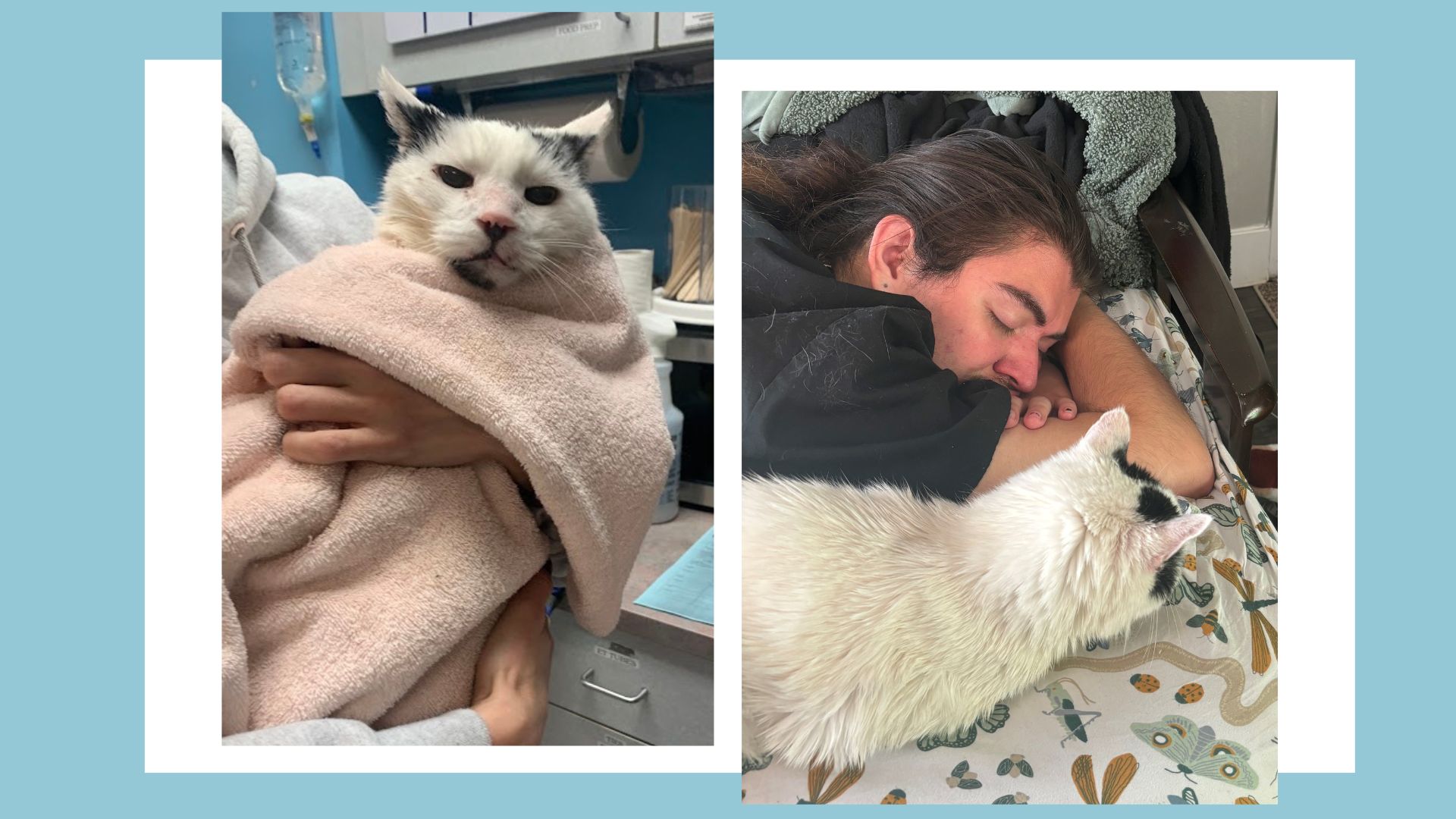
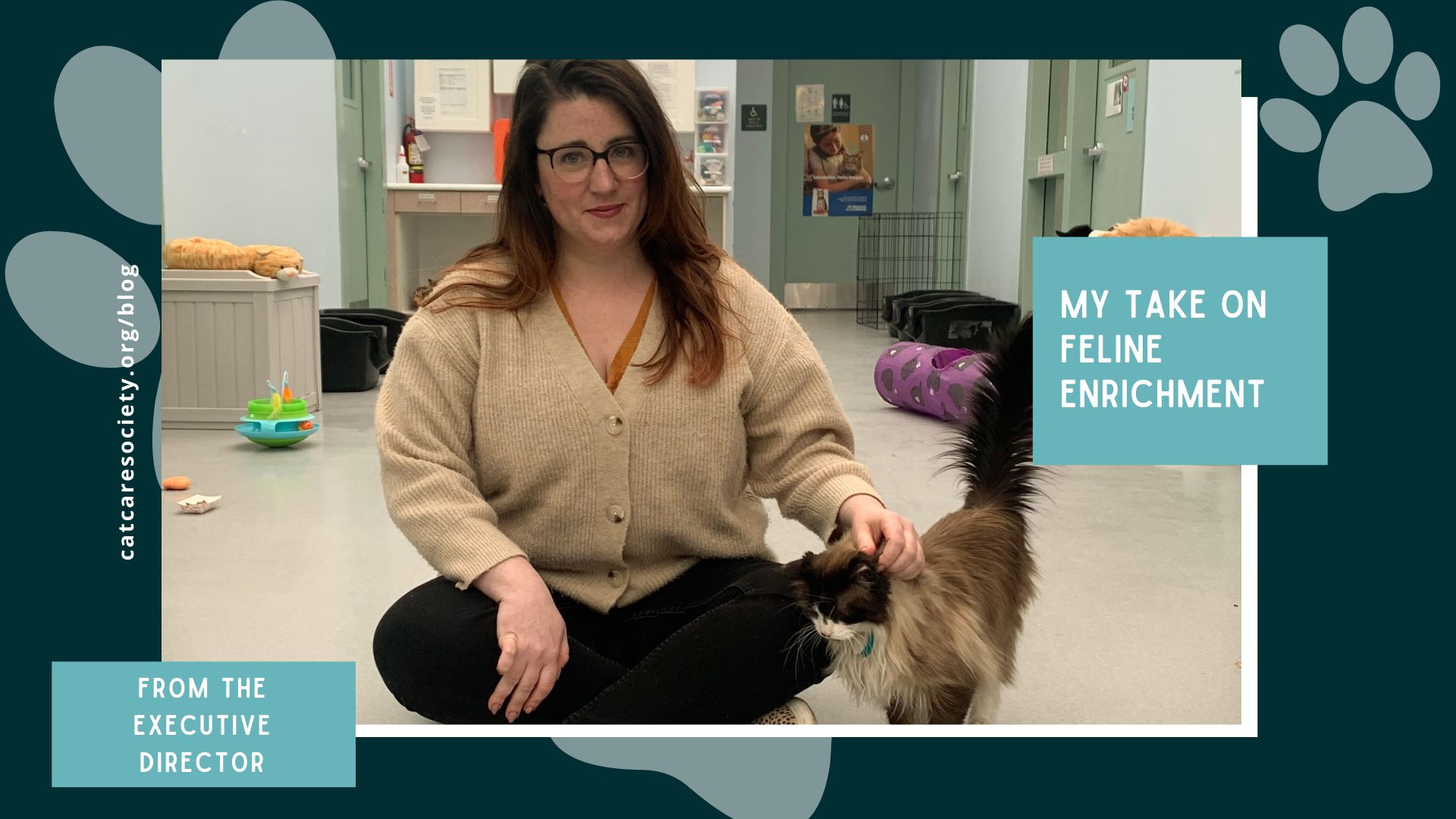
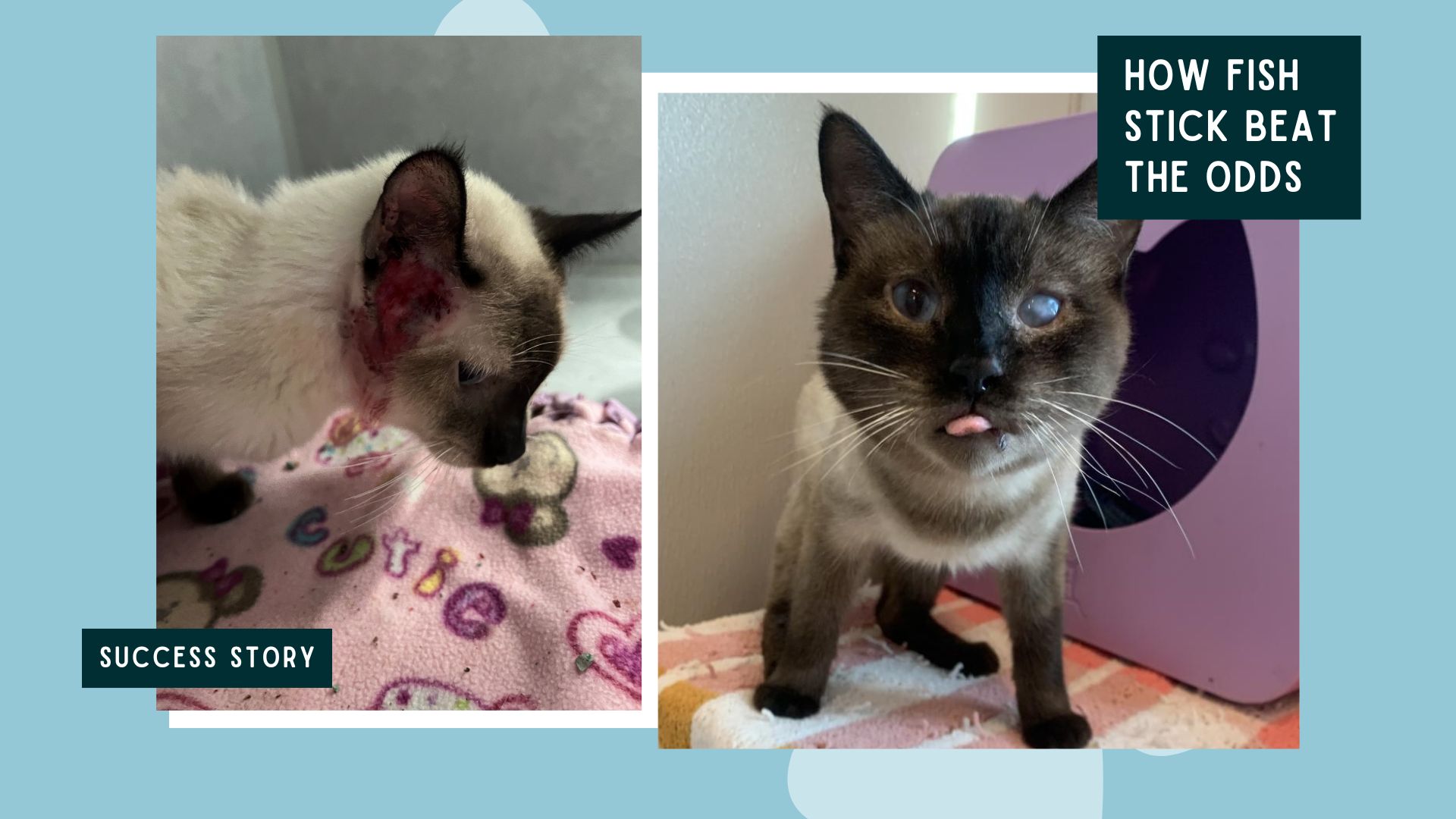
Abandoned, neglected and wounded after surviving a house fire, Fish Stick was found by a kind neighbor just in the nick of time. Little did anyone know, he was already up against more struggles than met the eye.
Believed to be the only surviving pet, this senior Siamese mix was down to 6 pounds and in dire need of medical attention. Realizing the level of care he needed, the neighbor reached out to our friends at Cooper’s Companions Animal Rescue for help. They brought him to Cat Care Society, knowing our specialty in helping cats that others would give up on.
Fish Stick had severe lesions on his face, neck, back and paw pads. He immediately received antibiotics, fluids and pain medication. He needed a cone to stop scratching at the sites.
Without veterinary treatment for so long, Fish Stick’s wounds were infected and bleeding.
“His teeth were horrific, his skin was falling off, and he was just a complete mess,” our lead veterinarian Dr. Cecily Palamara, recalled.
Further exams revealed he also had a heart murmur, severe periodontal disease, conjunctivitis, upper respiratory infection, anemia and about 8 more underlying conditions. Not to mention a positive ringworm test. Add to that, he was blind in one eye from a previous trauma. We called it his wizard eye.
Considering his multitude of issues, a successful long-term outcome was unclear. Our goal shifted to maintain his quality of life while treating what we could.
From the start, Fish Stick was a total lovebug. Regardless of any pain he felt, he maintained the sweetest disposition, purring constantly and rubbing affectionately on staff during every treatment. It seemed he was up for the fight.
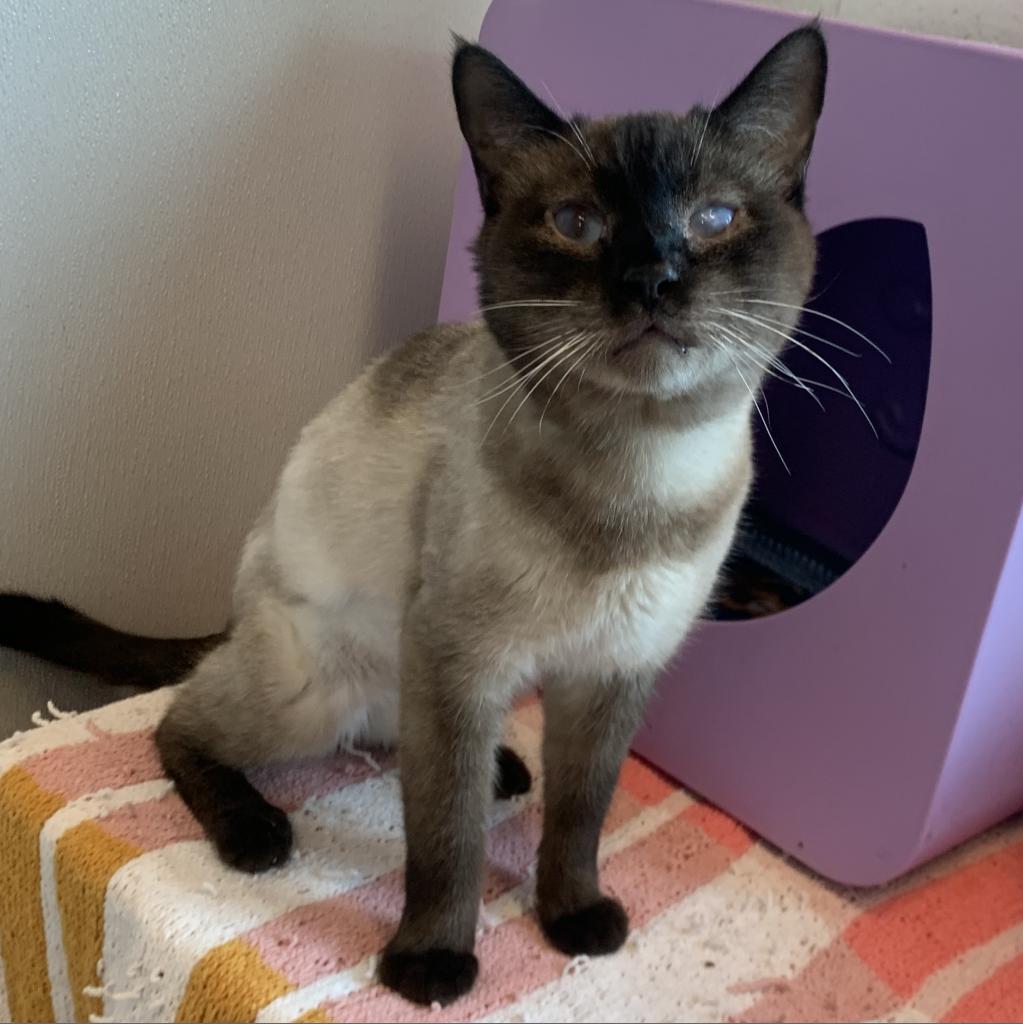
After addressing his most urgent needs, we slowly started ticking concerns off the list. Within a couple weeks, we saw significant improvement. He was gaining weight, hydrated again, his conjunctivitis was resolved, and his skin was looking better. Test results showed that some of his skin issues were not burn related, but were actually allergies. A month in, his liver values were completely resolved, anemia was on the right track, but his lymphocytosis was worsened.
Just when he took one step forward, there were another two steps back.
One employee stepped up to foster Fish Stick for close monitoring and an aggressive medication regimen.
After numerous medical setbacks, Fish Stick turned the corner in his foster home.
In foster, Fish Stick began to thrive. Just weeks in, he was markedly improved on nearly all accounts and finally clear of ringworm. His fur grew back in and he was at an ideal weight.
“He kind of became a celebrity,” Dr. Palamara recalled. “The whole team would come down for his rechecks. Every time we saw him, he looked better and better. He just needed some time and TLC, and he got that here.”
About 100 days after he came through our doors, Fish Stick was ready to become a candidate for adoption — with no less than 14 medical disclaimers. To make sure his adopter knew the extent of his conditions, a consult with our vet was required.
A host of medical issues was no concern for his adopter ready to open his heart and home.
Michael came to the shelter looking for a Siamese cat after losing his own. He learned about Fish Stick’s history and ongoing concerns but was unfazed, willing to take on whatever came with this friendly boy.
After going home with Michael, Fish Stick settled right in. He even gained a new friend, as Michael adopted another CCS cat, Jack, from us the same day.
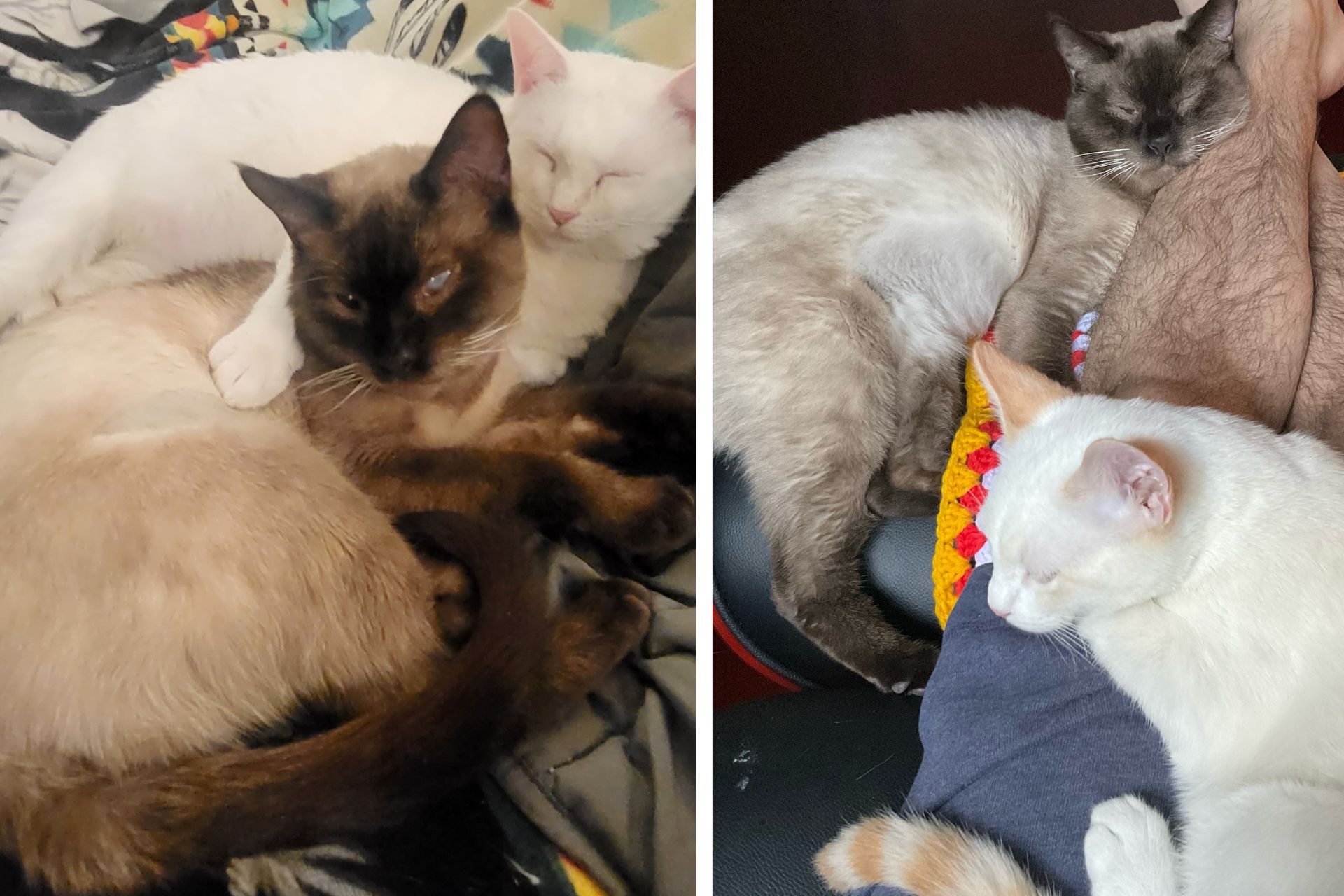
“Every day, both cats are getting more comfortable, and I’ve spent a lot of time playing with them,” Michael updated. “Jack is renamed Taz after the Tasmanian devil since he runs around like a tornado. Both cats are super smart and such a joy.”
Looking at him now, you’d never suspect Fish Stick made it through such a horrific event. The time and energy we put into this cat was significant, and his glow-up is a perfect example of who we are and what we do best. All in all, the cost of Fish Stick’s medical care alone was near $3,000. This does not include everyday expenses of living in a shelter, such as his food, litter, supplies or staff time.
Fish Stick pioneers a way for so many other cats who deserve a second chance after a bleak outlook.
We simply wouldn’t be able to take care of cats like Fish Stick if it weren’t for your support. Your tax-deductible donation ensures that more cats facing the worst have a chance at finding health and happiness in a new loving home.
With hope and gratitude,
EC Michaels
Executive Director
Cat Care Society
P.S. Thanks to you, Cat Care Society was able to help over 1,000 cats last year! Because we rely 100% on donations to keep up, we need your help to find loving homes for cats in need.
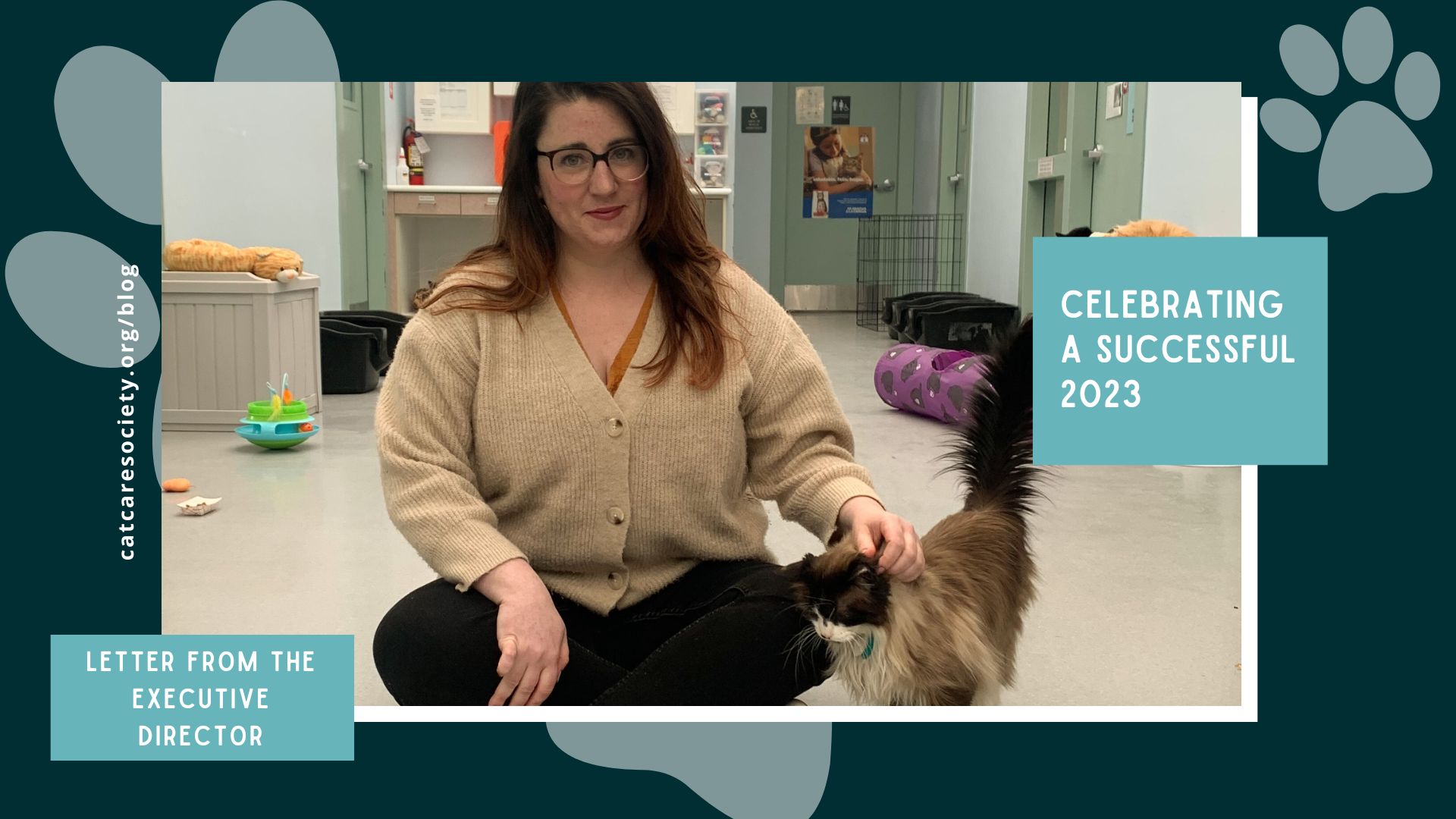
Now that 2023 is in our rearview, I am so humbled and excited to share our calendar-year stats and successes with you all. It was a busy year, with numbers up across the board. Even though we saw more cats in need than ever before, we also adopted more cats than ever before. Last year, over 1,000 cats were placed into loving homes thanks to your support!
In comparison, in 2022, Cat Care Society took in 860 cats and adopted out 750 of them.
Across the country, many shelters faced an increase in animals in need and owner surrenders. Economic conditions, inflation, lack of veterinary care and access, and the veterinary shortage, all affected the tough year that many shelters, rescues and animal welfare organizations faced.
I think it’s important to acknowledge that our statistics do not reflect the larger trend in animal welfare. It’s likely our specialty that makes us an anomaly. Because we care for so many special needs cats, our status as a limited-admission shelter, and our policies and partnerships, we recognize how special it was to help more cats find homes than we’ve ever been able to before. We also want to give a nod to the other shelters in our region, who work just as hard as we do to save and adopt as many pets as possible. We were happy to support their work by increasing the number of transfers we took in from our local shelter partners.
Over the last year or so, we’ve shifted how we think about taking in new cats. It’s easy to focus on the numbers above, but it’s just as important to think about the why behind them. For us, it’s all about balance for the entire shelter ecosystem.
This balance has helped us increase our support of special needs cats — as demonstrated by having over 100 diagnosable conditions we treat and place for — but we also know that CCS is more than that. No matter our niche, we will always support all cats in need. That includes young and healthy cats. Or cats who simply haven’t found a home in another shelter.
We’re proud to be members of the Metro Denver Animal Welfare Alliance (MDAWA) and work with many other organizations in the region to transfer cats in so they have a new opportunity here. We also aim to offer education for adopters on how to care for their cats.
Through it all, we balance our cat population against our resources; our staff size and budget must support our ability to care for the cats in our shelter. We’re constantly evaluating how we can grow proportionately. This is, after all, also aligned with our new strategic plan and CCS’ mission.
This level of control is one of the benefits of being a limited-admission shelter. By contrast, open-admission shelters are required to take in any animal that comes through their doors. If they happen to have an influx of complex medical cases (which require more time, money and expertise) at one time, they do not have the same options we do. It requires creative solutions — as well as some strain — on how they make it work.
Having worked in both types of shelters, I am so grateful for the unique community that Cat Care Society has. In my time here, I’ve challenged the team to be thoughtful and strategic in everything we do. Remaining a safe place for cats who need help, and finding them loving homes, is always our top priority.
I am more energized than ever to see what the rest of this year brings. As always, thank you for your support!
EC Michaels
Executive Director
Cat Care Society
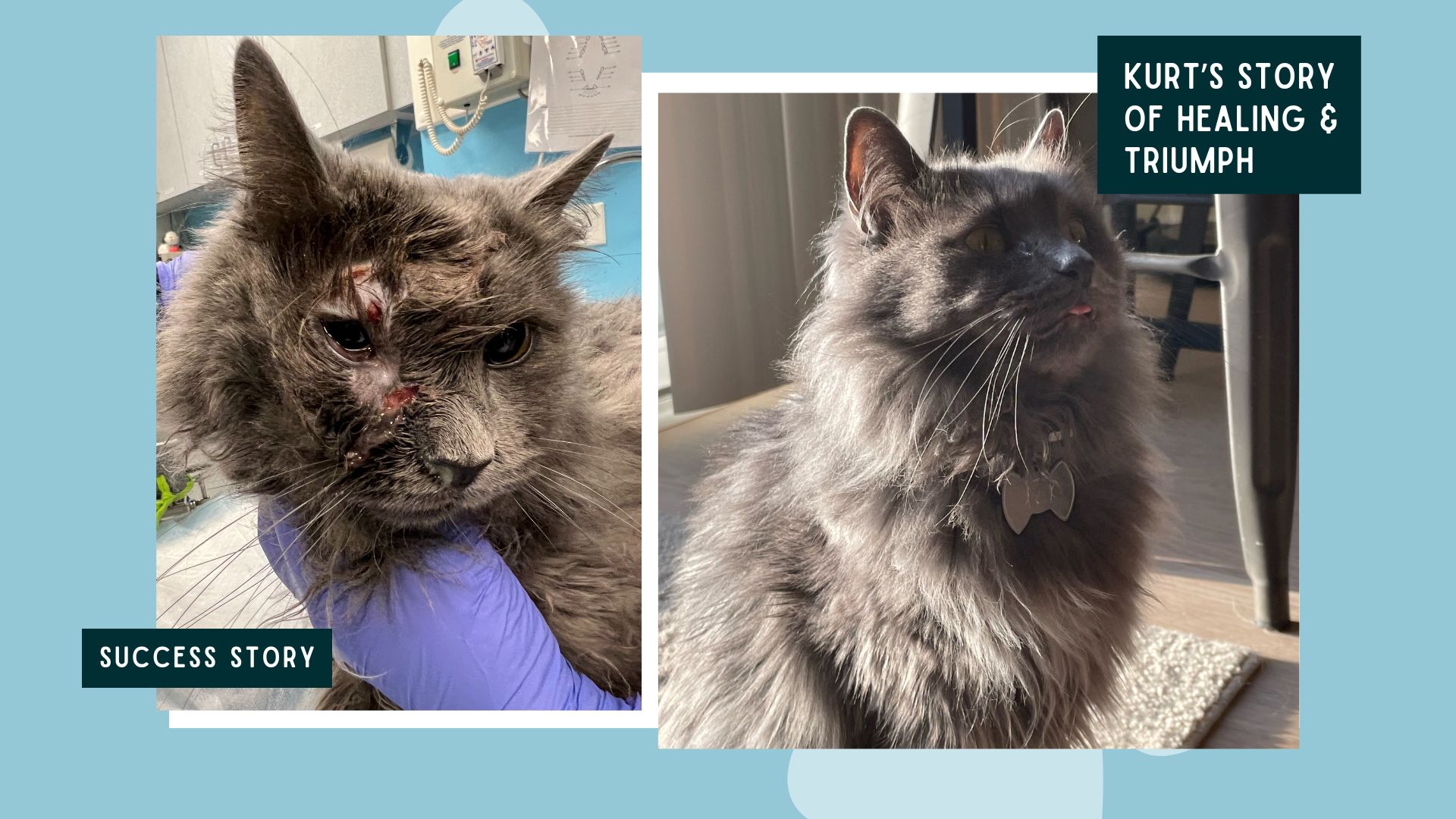
Sometimes in our line of work, we think we’ve seen it all. Routinely taking in special needs animals and complicated medical cases brings the sense of rarely being surprised or shocked. But every now and then, reality gives us a little kick in the form of a cat like Kurt.
Kurt’s (formerly Gray-Cin) previous owner recognized that he needed more medical care than she could give, and chose to surrender him to Cat Care Society last year. To say he was in rough shape would be an understatement. At only 3 years old, the extent of his condition left our medical team in awe.
Kurt, named after the famed Nirvana frontman, was in so much pain that he lashed out during his initial exam. He had to be put under anesthesia just so we could assess him and get to work.
His wounds were seeping, his tissues were severely diseased, and his eyes and sinuses were in extreme danger.
Add to that, his fur was severely matted, but a full-body shave is an easy fix compared to the time and care the open wounds on his face would need. Turns out, Kurt had a tooth abscess that had been neglected so long that it ruptured, spread to his nasal cavity, caused a severe infection and resulted in a visible, fluid-filled cavity in his cheek. His case was marked a priority, and our medical team quickly got to work.
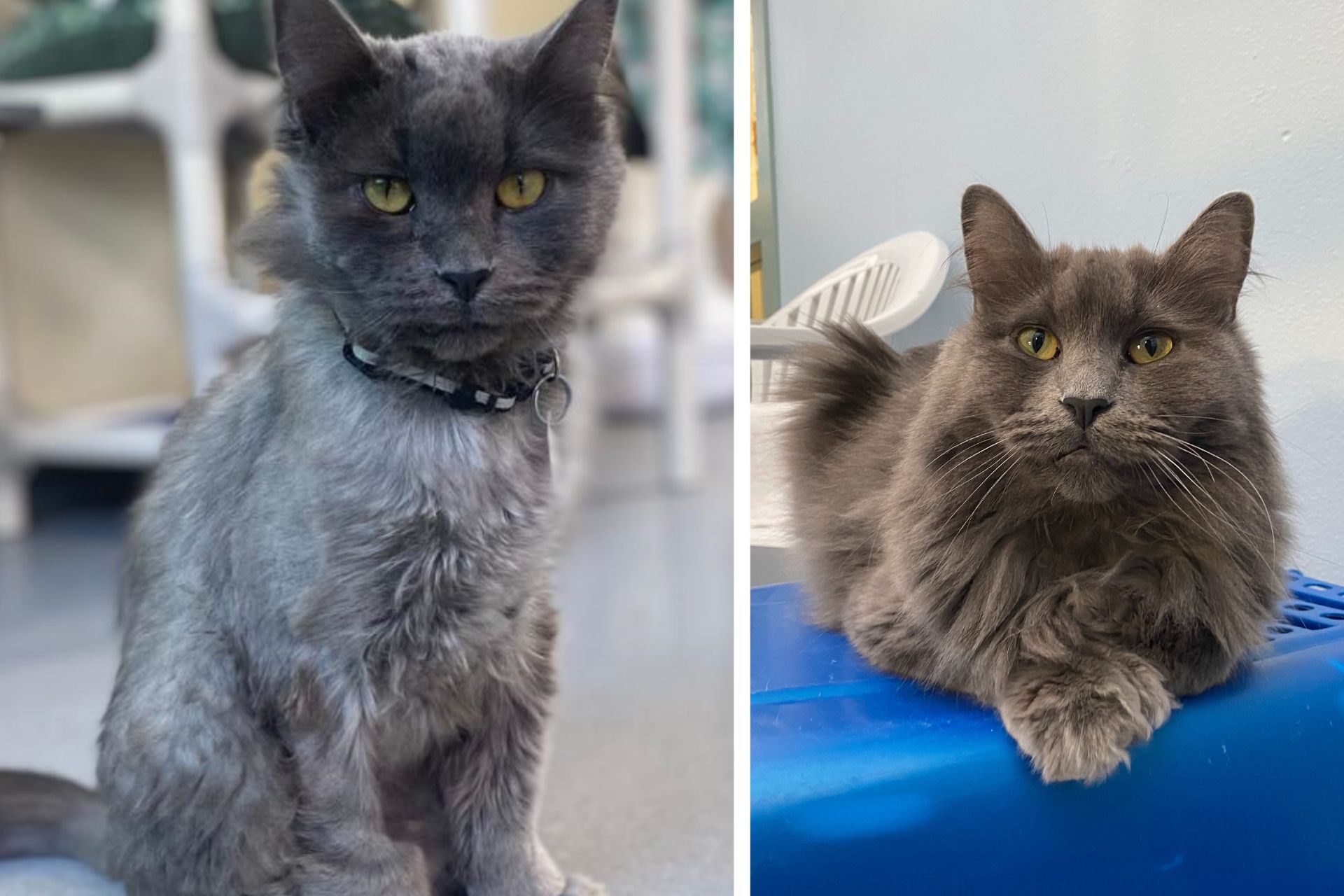
This alone could have been fatal, but there was more to come.
One of his teeth fell out when we first looked in his mouth, and it was clear that many more needed to be extracted before this gorgeous gray guy was going to feel the pain begin to subside.
He struggled to eat. His face was so swollen that it was difficult to see his right eye, and he was at risk of permanent damage without quick intervention.
Our lead vet, Dr. Cecily Palamara, said it was one of the most severe cases of sinusitis she had ever seen.
Kurt received X-rays, antibiotics and pain medication, and had his wounds flushed. He needed multiple surgeries to fully treat the wound and remove infected teeth and bone.
When he woke up from his first surgery, the relief in his eyes was immediate. The worst of his pain was finally gone. After a few days, he was talkative and asking for attention. After a few weeks, the swelling subsided. The abscess was almost completely resolved.
The result? Kurt became a gentle, happy lad who liked to play and be around other cats and people.
Once he was fully healed and up for adoption, it only took a week to find his new family.
Marc and his teenage son visited the shelter looking for a middle-aged cat who would do well with their dog, Bear. Kurt caught their eye thanks to his polydactyl feet and snaggletooth.
“He was bedraggled; I could tell he was in a rough spot but just needed some support,” the high schooler recalled.
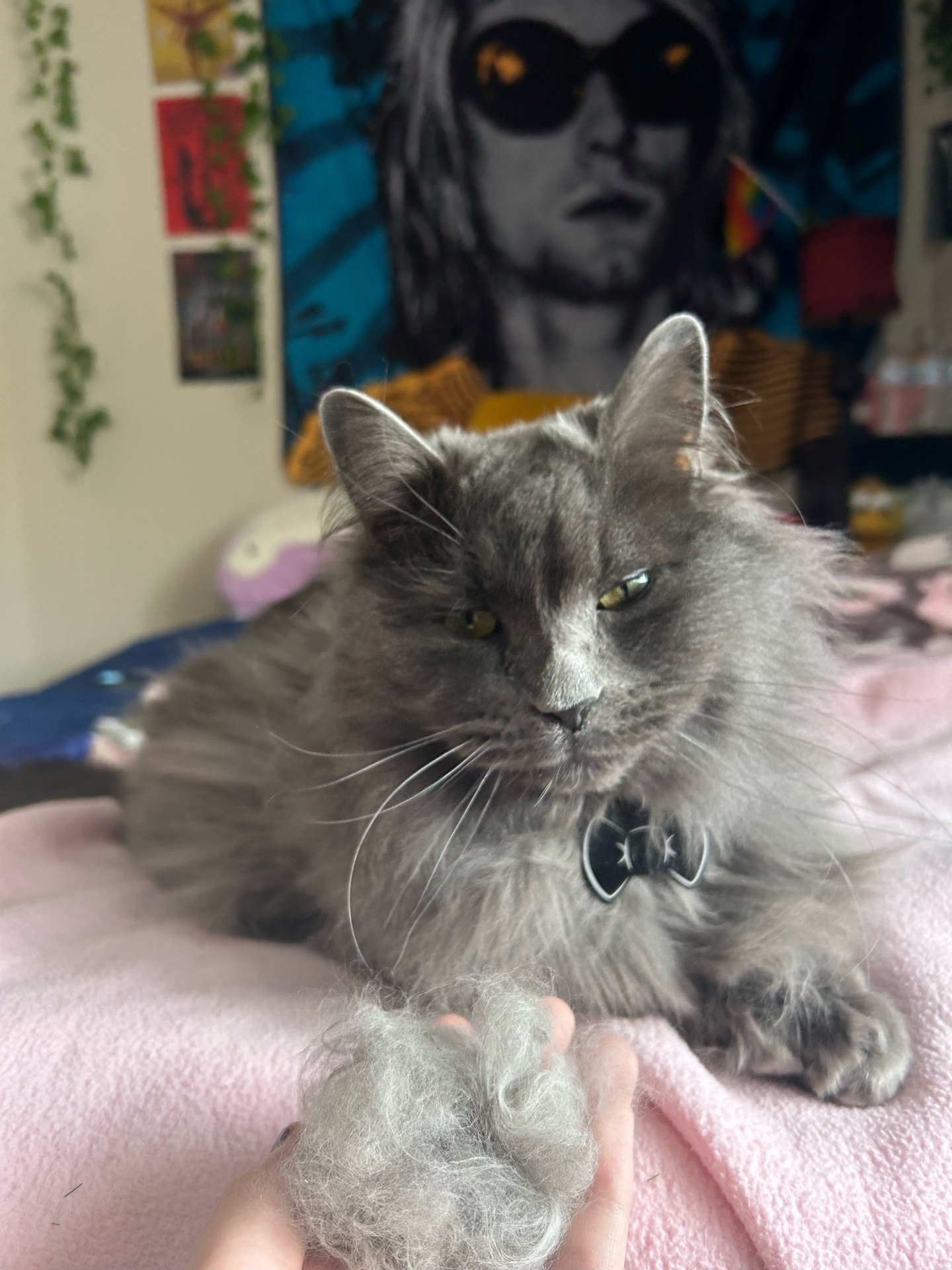
Kurt adjusted pretty quickly to his new home, becoming a confident and independent explorer, and never losing the loving nature he showed from the moment he started to feel better.
“He has been the sweetest boy since we got him,” Marc’s son said. “As he came out of his shell, he started to play and make biscuits. He always talks to us, asking to be pet or be fed. He’s the biggest cuddler ever!”
Due to the extent of his injuries, Kurt’s sinuses and tear ducts will never quite be the same, though he is comfortable again. Kurt’s family reports that he still sneezes and has a runny nose occasionally, but his beautiful coat has grown back in and you’d never know what he went through.
Kurt is now a very sassy cat who knows how to meow till he gets what he wants. He struts around his home, loves catnip mice, and relishes in chin and belly rubs.
Kurt’s case is an extreme example of the importance of cats’ dental health. Because dental disease is so prevalent, tooth root abscesses are common but can be prevented with good oral hygiene and regular vet visits.
It was 317 days between when we first met Kurt and when he went to live with Marc and his family. That’s dedication and care, and it’s what we do best.
Even though Kurt’s case is a unique one, his story is just one of countless cats who receive top-notch medical care above and beyond what many other shelters would be willing to take on. It’s a testament to the spirit of Cat Care Society’s approach in caring for all cats and the dedication of our team.
We thank each and every one of you for your support in continuing to help cats in need.
With gratitude,
EC Michaels
Executive Director
Cat Care Society
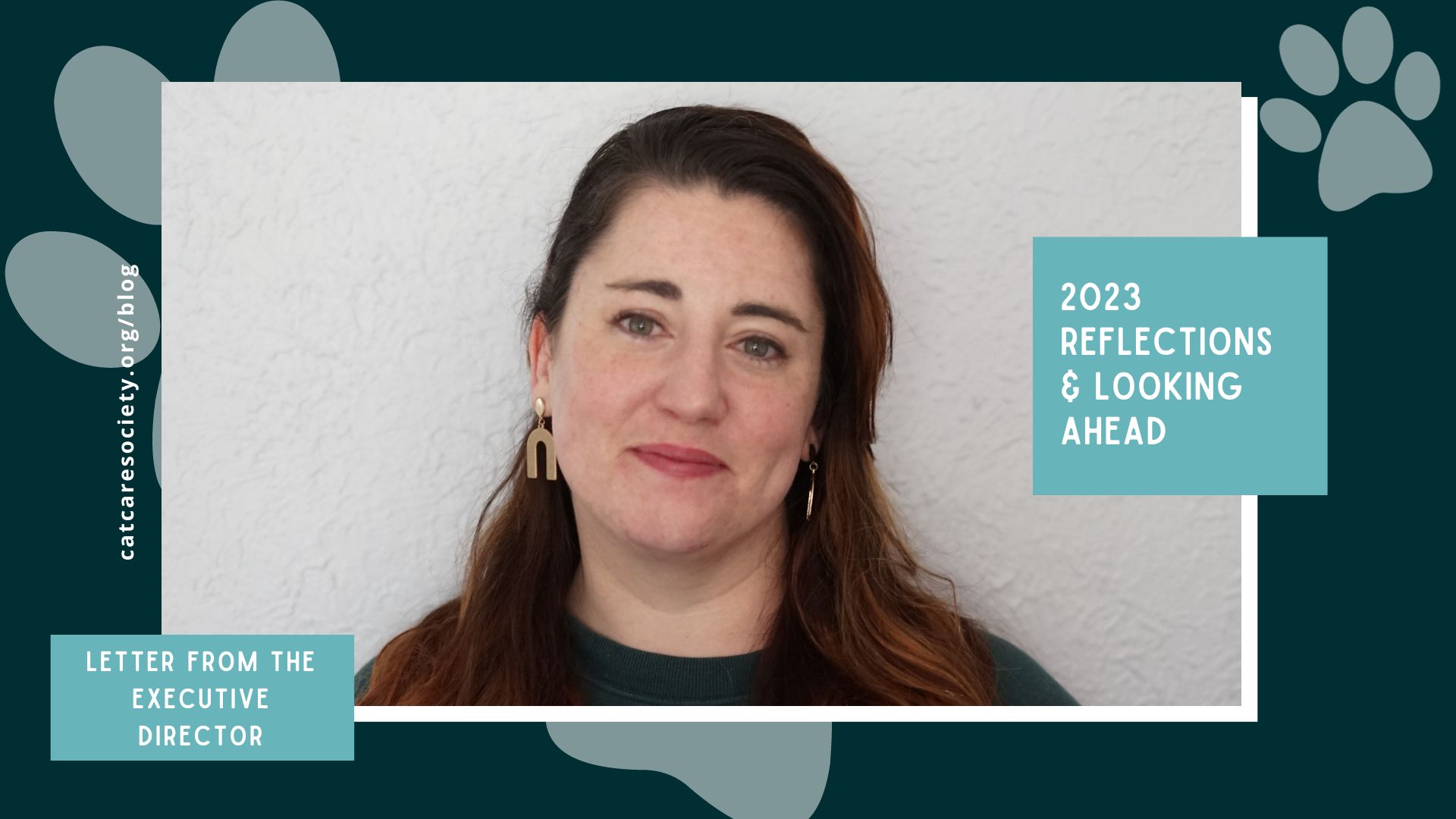
As we begin to put a wrap on 2023, I reflect with so many emotions on this past year. My first full year as executive director of this dynamic organization has come with many highs and, as unfortunately happens in so many shelters, a few lows. But above all else, I am struck by overwhelming gratitude.
Not only have we been able to increase our reach, expand partnerships and bring on talented new team members, but we’ve helped more cats than ever before. Our length of stay (how long a cat, on average, is in our care before adoption) has decreased to 41 days — which is pretty incredible considering we increased our intakes and transfers and consistently welcome many special needs cats who others would deem hard to adopt.
For every animal we saved through groundbreaking medical care, new enrichment and socialization techniques and adaptive community services and programs, I am more filled with hope than ever. This summer’s launch of our new strategic plan and organizational identity set forth a strong map forward as Cat Care Society continues to evolve to meet the needs of our cats and our community. We are already beginning to see the earliest fruits of these labors, as we strengthen our commitment to our staff, systems, volunteers, visibility, and our future.
With more focus on developing our emerging leaders and staff members, we’ve been able to send CCS faces out into the community to network with their peers, learn from other organizations and fine-tune their knowledge and skills for each of their unique roles. I am so grateful to industry organizations like the Association of Animal Welfare Advancement, ConnectingColorado, Animal Welfare Association of Colorado, Metro Denver Animal Welfare Alliance, West Metro Chamber of Commerce and other shelter and community partners that keep us connected to trends, tips and information as we continually seek to do better.
Soon you will see further details on the impact of our work for our last fiscal year (stay tuned for our annual report coming out in early January!). For every statistic and data point, there is a cat with a story. It does not land lightly on us that the impact we have on cats’ lives is literally life-changing. I’m so proud that we’ve been able to help more cats than ever before, with over 1,100 cats coming through our shelter in the past year. While I wish we could tell the story of each and every one of them, I hope you find some time to read the stories of some of our longest-staying or hardest-to-adopt cats, which you can find on our website under Success Stories. Even just putting together 10 of our most impactful cases moved me deeply. It would be such an understatement to say that I am blown away by the dedication, kindness, compassion and work that our team puts into the lives in our hands. Time after time, CCS staff members have shown that we don’t give up. The amount of time, effort, money and resources that we put into our cats, is truly something special and paints just a small picture of what it’s like to work in this field. I will never be able to thank my team enough for the work that they do.
CCS is and always will be an organization that is committed to the goal of finding cats loving homes. However, we will never rush this process and have put steps in place to ensure that each cat is truly ready. We are focused on providing the best medical care and support for each animal that comes through our doors by understanding his or her unique medical and/or behavioral needs. We consistently ask what a cat needs to live its best life and offer transparent information to potential adopters about what to expect and support that animal. We don’t just diagnose conditions; we go a step further to dig into the root cause of what a cat needs to truly thrive for his or her future.
The fact that we always go the extra mile is one the things that makes CCS so special. Just one example is a cat named Amaryllis, a stunning 8-year-old lovebug who arrived in April. Amaryllis came to CCS as a medical transfer, underweight with a heart murmur, alopecia and in need of a dental. At first, she seemed to be in decent shape, considering, but then we noticed something else. After a few days, a medical recheck found a distended abdomen and fluids around her reproductive parts. After a full exploration, we found lingering issues from an old surgery and treated it. Because we took these extra steps, we found something that easily could have been missed and are confident her outlook is now even more positive.
I realize that the CCS many of you have known and loved for years is beginning to look a little bit different. I want to assure you that every change that has been implemented has been done with much discussion, care and concern for the cats and people we’ve served throughout our rich history. In fact, I don’t see it as change as much as it is adapting. The pandemic turned the world on its head and shifted many ways of thinking. In our world, trends continue to shift and new research offers new opportunities. To survive in this day and age, we must be agile and know when to pivot. I am forever grateful to every single staff member, volunteer, donor and partner who has stuck by our side as Cat Care Society evolves and grows. We are building on our rich 40-plus year history and setting the foundation for so many more good things to come. We are investing in our people and our metro community. This solidified identity and mission ultimately allows us to help more cats!
Our most recent Clear the Shelters event proved that our region is ready to do this, and we have a community willing to say yes to the tougher cases. We celebrated our most adoptions in a single day, ever last August! I am also filled with gratitude for the overwhelming response once again to our Colorado Gives Day fundraising campaign. We exceeded our fundraising goal, raising just over $152,000 for the shelter cats. We are overwhelmed by your generous support and endlessly grateful. Now, we are more invigorated than ever to bring this energy to the larger community.
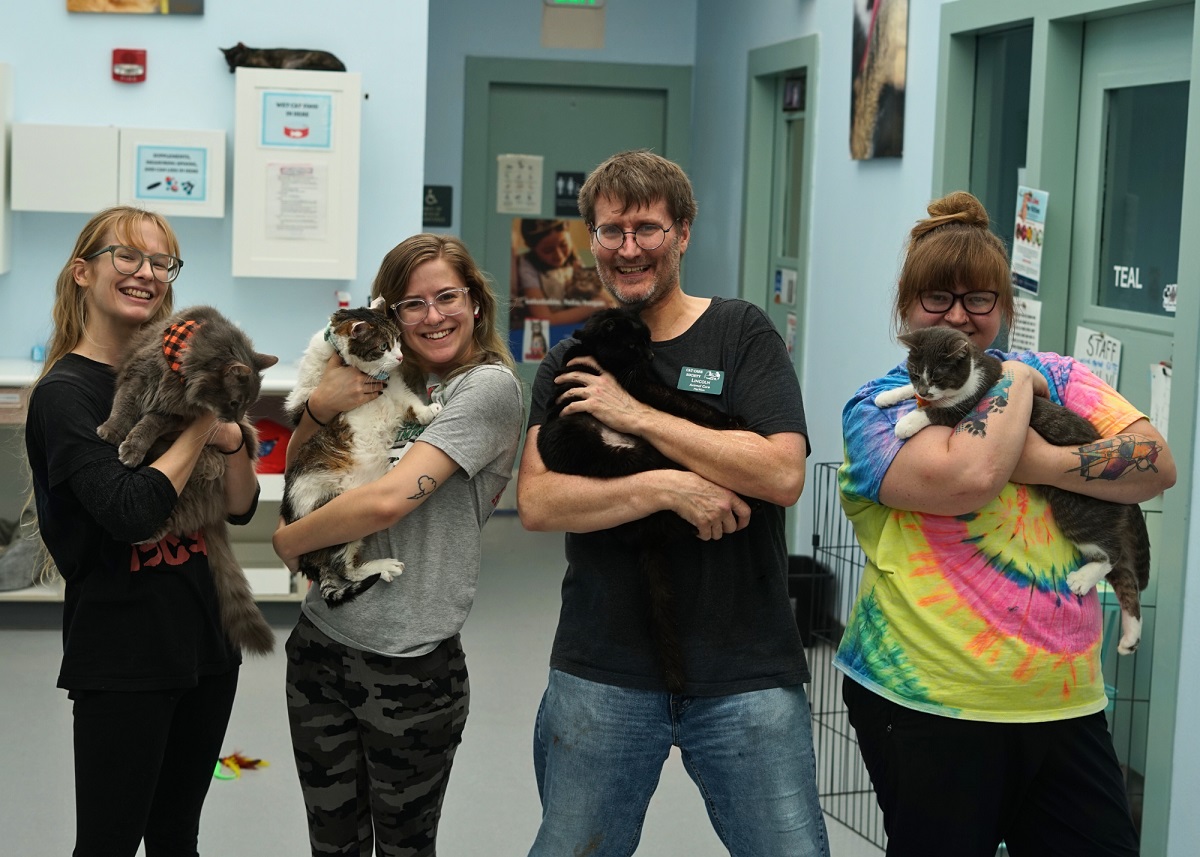
Of course with rising costs of our own and more cats in need than ever, we need your continued support. As we look ahead, we hope to purchase another surgical table specifically for dentals. One of the biggest bottlenecks of sheltering in general is dentals, and because CCS takes in so many older cats, our medical wait list is often what prevents us from helping more cats due to the resources we have. Even one more table in our surgical suite would mean hundreds more cats getting earlier dental treatment than before. We are also building plans to enhance our feline behavior & enrichment program and look to purchase more supplies to support caring for cats that need a little more time and attention.
As CCS continues its forward motion in a changing landscape, we are as dedicated as ever to our core values, positively transforming our staff, systems, people, processes and visibility for a bright future, as guided by our strategic plan. To ensure this long-term success, we will remain adaptable and invested in the well-being of our cats, our people, our facility, our partnerships and our community. As we navigate rising costs and increased need, we’re also opening our doors to more partners across the state, bringing in more animals and broadening our outreach. Our team is excited about continuing to build a beautiful foundation based on trust, transparency and the most loving care for cats in our region. We will continue learning, growing and striving to be a place where no cat is left behind. Your support can make this possible!
Your philanthropy allows us the power to change the lives of not only the cats that we take in and care for, but the lives of their future adopters. It is what enables Cat Care Society to go the extra step for each and every cat that comes through our doors.
We hope we can count on you as an ambassador to this work as we think critically about our future. The world of cats is ever changing, and we’ve demonstrated we can be successful while also keeping CCS’ values and identity at the heart of our every day. As we celebrate this special community and each cat who finds a home, I invite you to join us.
We believe in transparency and always want to be available for questions or clarifications around our statistics, policies or procedures, and ask that you simply reach out if you hear any information about us and want to ensure its validity. Email executivedirector@catcaresociety.org to set up a time to talk.
Thank you, and cheers to a happy and healthy New Year filled with feline friends.
Warmest regards,
EC Michaels
Executive Director
Cat Care Society
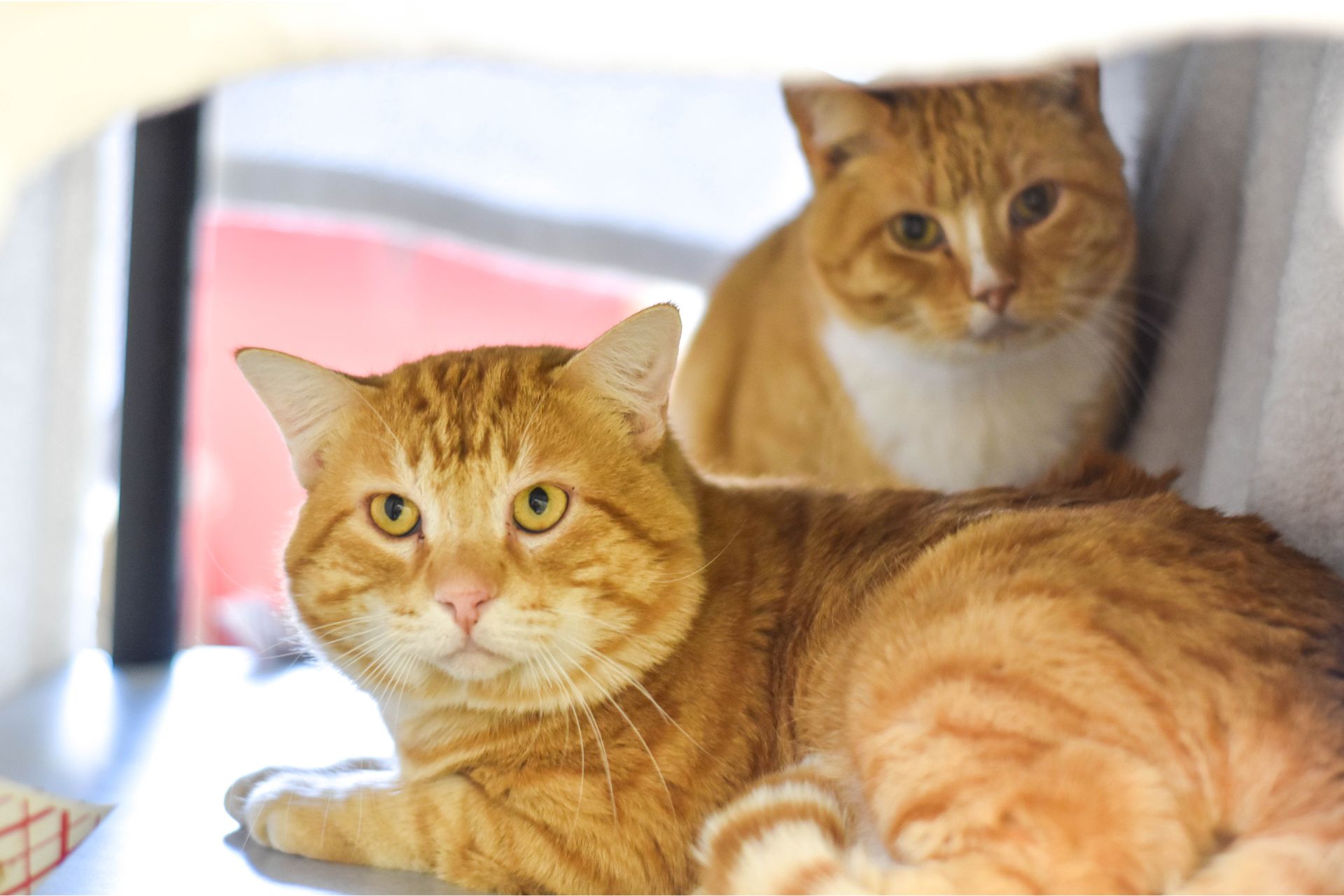
Probably one of our shelter’s biggest transformation stories comes in the form of two bonded orange tabbies named Garfield and Big Red. Both came to us as ferals from other shelters within days of each other in January 2023, and both brought with them an FIV+ diagnosis.
Big Red (the one with the white blaze on his chest) arrived from Nebraska as an overweight stray. He appeared mostly healthy, friendly but timid and easily overstimulated. In his first exam with our medical team, he leaned into pets but was not overly comfortable being handled. We spotted some mild gingivitis and dental disease, but were unable to obtain a blood panel. Big Red became so stressed out from the experience that he became aggressive and fearful. We decided to forego his dental procedure and inform his future adopter to discuss treatment with a private vet.
At the end of Big Red’s first week, he was still fearful, hiding in his room on a shelf behind blankets. But after a few minutes of us in the room, he would visibly relax and allow pets on his cheek. He startled easily, so we moved slow around him. Within a few more days, shelter visitors told us that Big Red was allowing them to pet him extensively and was even rolling over to show his belly!
A few days before Big Red entered into CCS’ care, his soon-to-be-buddy Garfield arrived from another Colorado shelter after bouncing around other rescues in the Midwest. And he proved harder to handle.
From the start, our team was unable to touch Garfield. He lunged, was fractious and needed sedation just to be examined. We found that he had a corneal ulcer in one eye, periodontal disease and ruptured abscesses from a recent neuter. We were concerned about how to care for him and considered finding him a foster in the hopes he would be calmer in a home setting.
In the meantime, Garfield was moved into our FIV+ room, and we hoped he’d get along with other cats. The first day was promising; he laid next to others without issue, and we watched him closely while he acclimated. But by Valentine’s Day, there was no love in the room as our team found evidence of fights between Garfield and Gordon. He was also consistently swatting and hissing at staff who tried to offer him some attention. It was clear he was in distress.
Days later, he needed another exam to check his scrotal abscess, he again refused to be handled and needed sedation. The good news is his wounds had healed, but we were worried about not being able to medicate him. We reached out to his prior shelters for more information and began considering all of our options, including a transfer to a barn cat program and worst-case scenario, euthanasia.
Garfield’s advocates stepped up to the plate, dedicating themselves to the challenge of avoiding the latter and getting creative with socialization methods. Garfield responded less dramatically to being touched with a long brush — we had hope! Then the real magic began when an adoptions counselor offered him some Churu (a squeezable treat paste) on the end of a bite glove. He happily licked the treat and began relaxing his ears. Eventually, he ate the treat directly off her fingers! He returned a couple slow blinks, but was not yet ready for head pats.
The very next day, he approached our animal care lead for breakfast — but only ate when she was fully still. Another animal care tech Kelly tried one more Churu, with significant success. Standing to the side and speaking soft, Garfield lapped up his treat while Kelly engaged with him. No hisses, no swats and no fearful body language!
Kelly had just created enrichment charts for our cats to note who responded best to various sensory needs such as smell/taste, puzzle/forage, play/visual, and comfort/hiding. We used Garfield to test some new methods.
@catcaresociety Our FIV+ boys Big Red and Garfield had a rough start here at the shelter. When they first came to us, Garfield showed signs of aggression and wouldn’t let anyone near him, often swatting or hissing at anyone who entered his room. Big Red had issues with the other FIV+ cats and wouldn’t let anyone near him either. With patience and reassurance, CCS staff has been working on socializing them. Together, they learned to trust humans and have done a complete 180 in just a month! Now they greet you when you enter their room, accept pets (especially if rewarded with kitty gogurts) and have grown quite fond of each other. #fyp #catsoftiktok #catcaresociety #adoptdontshop #sheltercat #coloradocats #denver #fureverhome #nonprofit #adoptme #gingercat #orangecat #thingstododenver #denver #fivcat #fivcatsoftiktok ♬ I Think I Like When It Rains – WILLIS
“In Garfield’s case, he mostly needed comfort and hiding enrichment and some smell/taste with treats and food,” Kelly said. “Many of the staff were going into his room throughout the day to feed him Churu and other tasty snacks in order to associate humans with food and positive feelings. We also have music speakers in the room that play soft piano music. I figured out how to change the channel to Colorado Public Radio so that Garfield would get used to human voices and positive energy with music.”
As the days went on, he slowly gained more confidence. After enough quiet time with one person, he began to allow being combed and touched. Just a few days later, he began picking up his head, slow blinking and meowing at our team when they entered his room. It was slow but steady progress.
Little by little, Garfield became more talkative and friendly, rubbing on legs, allowing scratches, offering headbutts, purring, crawling into laps and making biscuits. It was a 180! We couldn’t believe what a sweet cat he had become.
Meanwhile, Big Red was struggling with other cats. He seemed so scared that he was hiding and trying to scale the walls. Since Garfield was doing so well, we wanted to see how they would do together, hoping that Garfield’s progress would rub off on Big Red. Queue the love story, because we had no idea how quickly these two boys would bond.
“Their personalities really started to come out around this time,” Kelly recalled. “They were so chatty and vocal. They would walk side by side with their tails intertwined and eat out of the same bowl (even if you gave them two food bowls!). They also used the same litterbox despite having two. We joked that they were so bonded that we were pretty sure they were dating!”
Our shelter manager called Garfield and Big Red’s turnaround amazing and commended the work our animal care team and volunteer socializers did for them. “We try not to bond cats together, but these two just gravitated toward each other,” she said. “They were like a couple. Big Red was the jealous type and swatted other cats away from Garfield. It was just a constant cuddle puddle.”
These two lovers did indeed find their happy ending together, too. Adopter Jason was originally thinking about getting a companion for his senior cat of 23, but was worried how he’d do with a new friend. He began browsing our website and kept tabs on who was up for adoption, but just kept thinking it was the wrong time. But then his cat passed on, and he stopped into the shelter on his way back from a work trip to see if he was ready to adopt again.
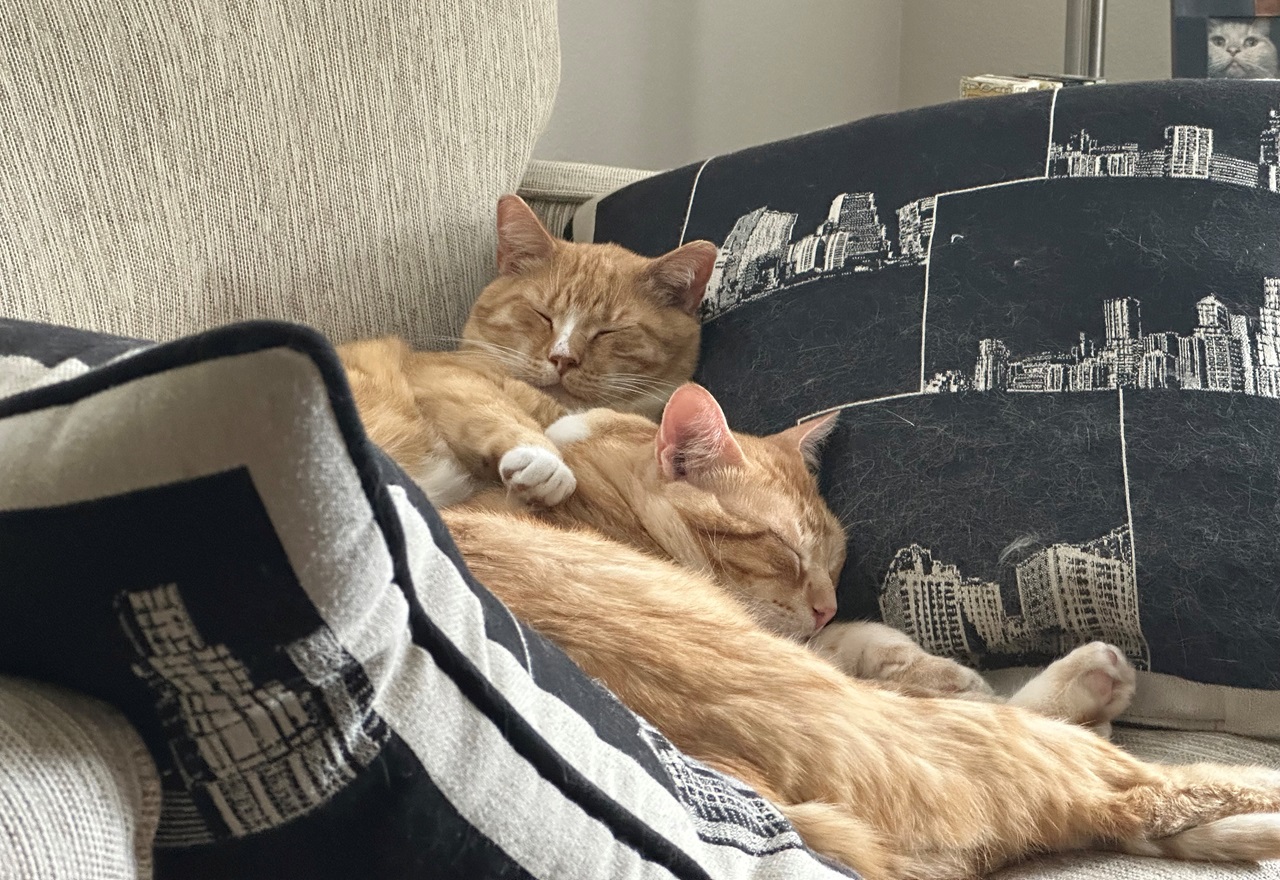
“[Garfield and Big Red] were there for a long time, and it just seemed that they really just needed a home,” Jason said. “I wasn’t sure who they were to become, but I just knew I could provide the home they deserved. While I will always remember and cherish the time I had with Rupert, it turns out that it was the right time to make new memories with ‘the boys.’’
Jason renamed them Oliver and Winston, respectively, and brought them home in April. Just like in the shelter, it was Oliver who opened up first, with Winston cautiously following suit. He says they have been the best company. “They are still really close to each other and remain best friends,” he said. “They have both opened up to loving and playful personalities, while Oliver is more outgoing and Winston a bit more reserved. They just love to be near you and hang out. In the morning and the evening Oliver enjoys the zoomies, running between rooms and sliding on the floors batting and chasing his favorite mice. Winston will play and chase ghosts, meowing in his own imaginary world. During the day, they enjoy watching the birds and squirrels out the windows, and taking naps in their favorite chair.”
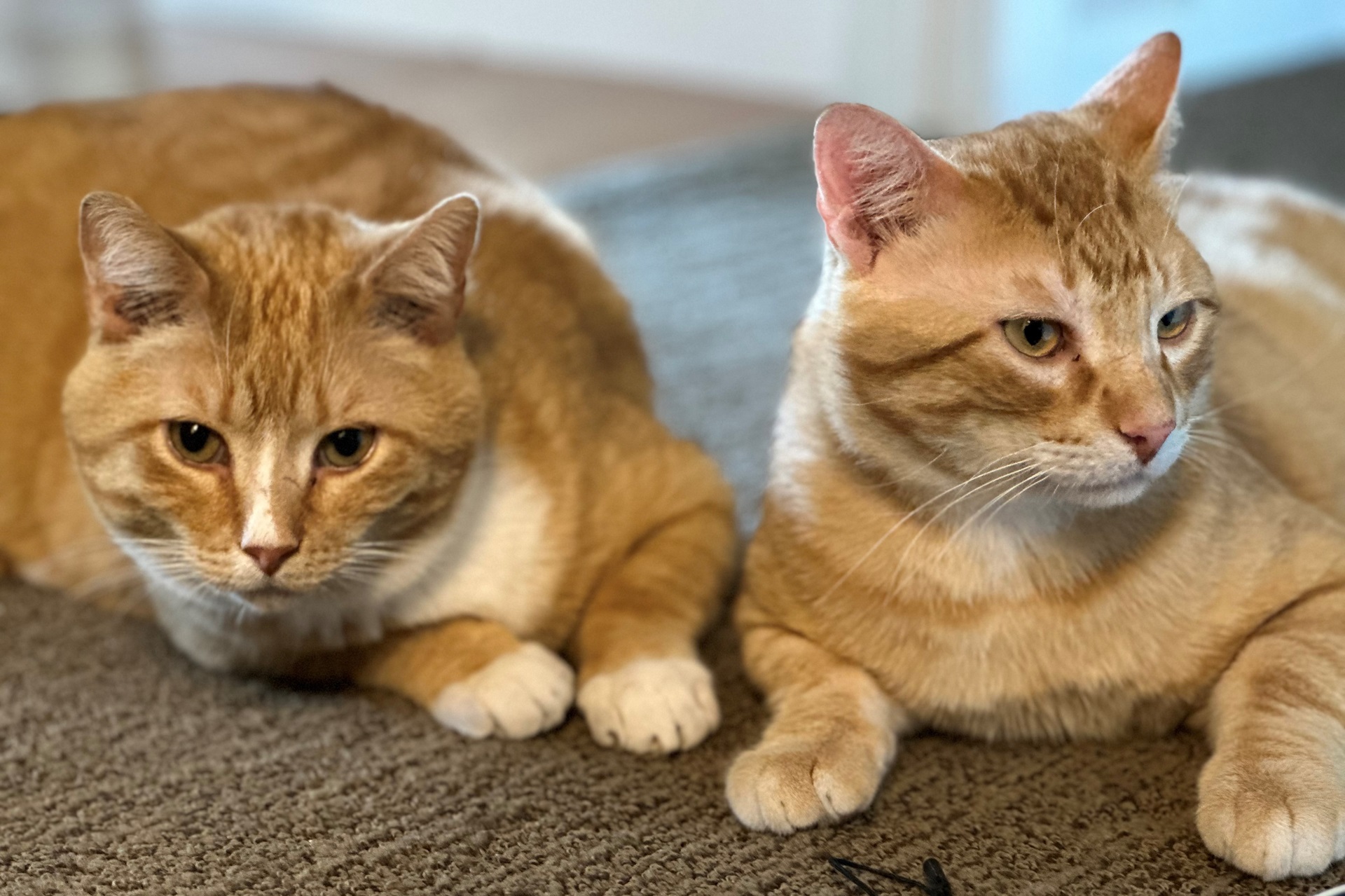
For so many cats, a shelter environment doesn’t allow their true personalities to shine. That’s why our goal is always to place our cats in adopter or foster homes.
“It made me so happy that I was a part of helping [Garfield] to bring out the love that I always knew that he had,” our volunteer socializer Vicky said. “They are now in a loving home and get to love and be loved. Every day that I go to Cat Care Society, I get to help another little kitty cat and am filled with gratitude to be able to do that.”
We thank each and every person who’s helped any of our shelter cats. Together, we’re making a world of difference in the lives of cats in need.
Have you adopted from CCS in the past? We’d love to hear how it’s going! Send us your adoption success stories (and photos!) to be featured in our #adoptionupdate series on social media or on our website.
Feel compelled by our work and want to help more cats in need find loving homes? Please send us a financial gift to provide life-saving medical care and adoption services to cats like Garfield and Big red. Donations can be made online HERE (and all funds received from Nov. 1 to Dec. 5, 2023, count for our Colorado Gives Day fundraising goal, with extra opportunities for matching incentive funds. We appreciate your support!
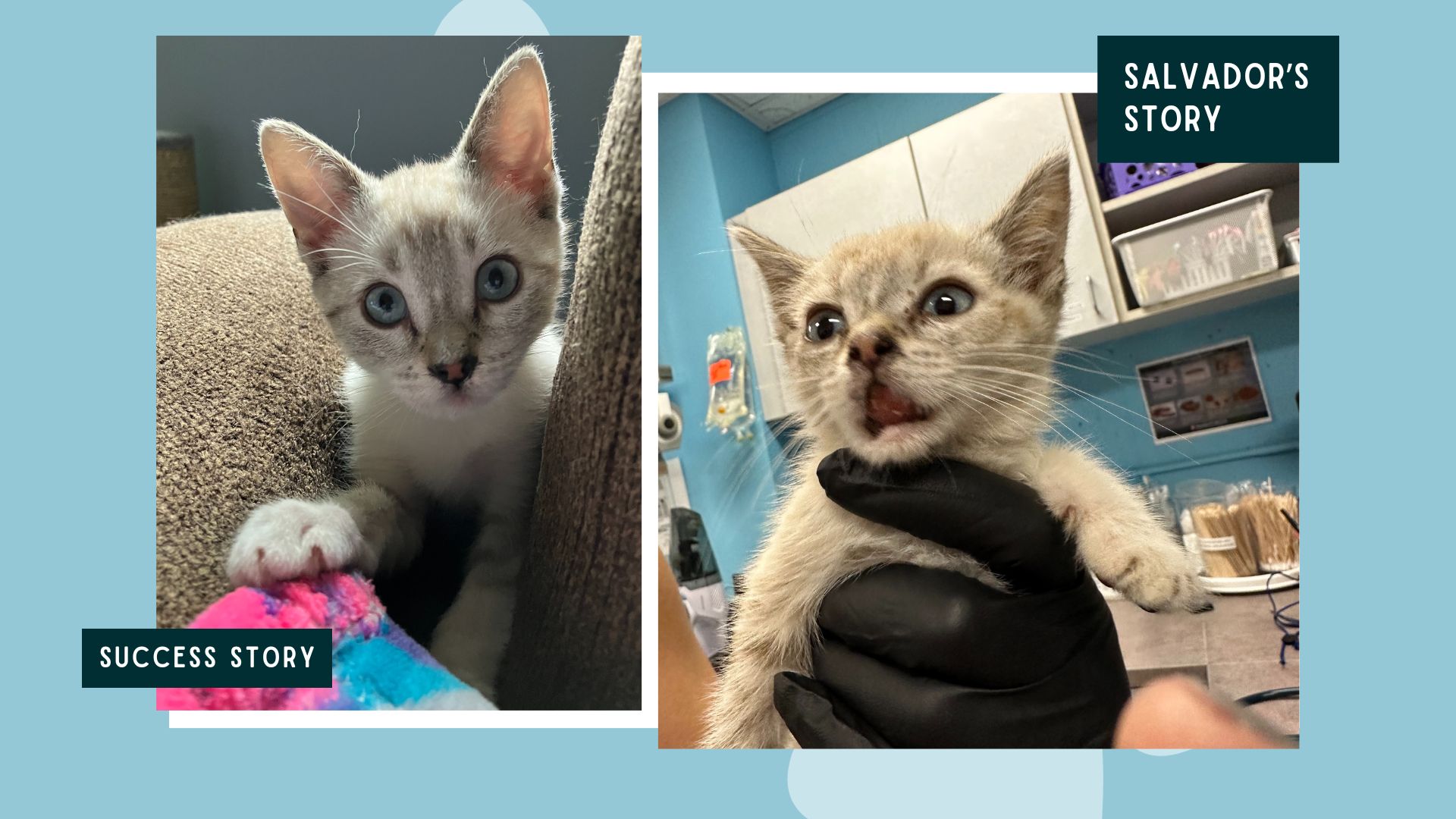
As a cat shelter that specializes in providing care and finding homes for special needs cats, we often come across unique medical cases. It’s rare for one of these cats to be so young and tiny, though.
Thus was the case when we heard about Salvador this summer. A small Siamese kitten less than 1 pound and a couple months old, Salvador had already experienced major trauma. One of our shelter partners, RezDawg Rescue, who specializes in rescuing unwanted animals in high-risk situations brought him to us, along with significant and urgent medical needs. We don’t know exactly what happened, but it was obvious that his mouth had been affected. His jaw was barely hanging on to his face.
Salvador was a stray found near a reservation in New Mexico at a flea market by a local citizen who had taken his dogs for a walk in the area. Thankfully, this good Samaritan brought him to someone that could help.
We rushed Salvador to our medical team, who confirmed that his lower lip was traumatically separated from the jaw, but there was no evidence of a fracture. Our lead veterinarian, Dr. Cecily Palamara, DVM, guessed that the injuries were due to a predator attack. “His injury is not uncommon in cats, and is often caused by a dog or other animal bite, sometimes when the victim is peeking through a fence,” she said.
Two days later, Salvador’s lip was repaired by Dr. Palamara, his jaw was reconstructed and multiple teeth were removed due to bone exposure. Like the little fighter he is, he did well under anesthesia.
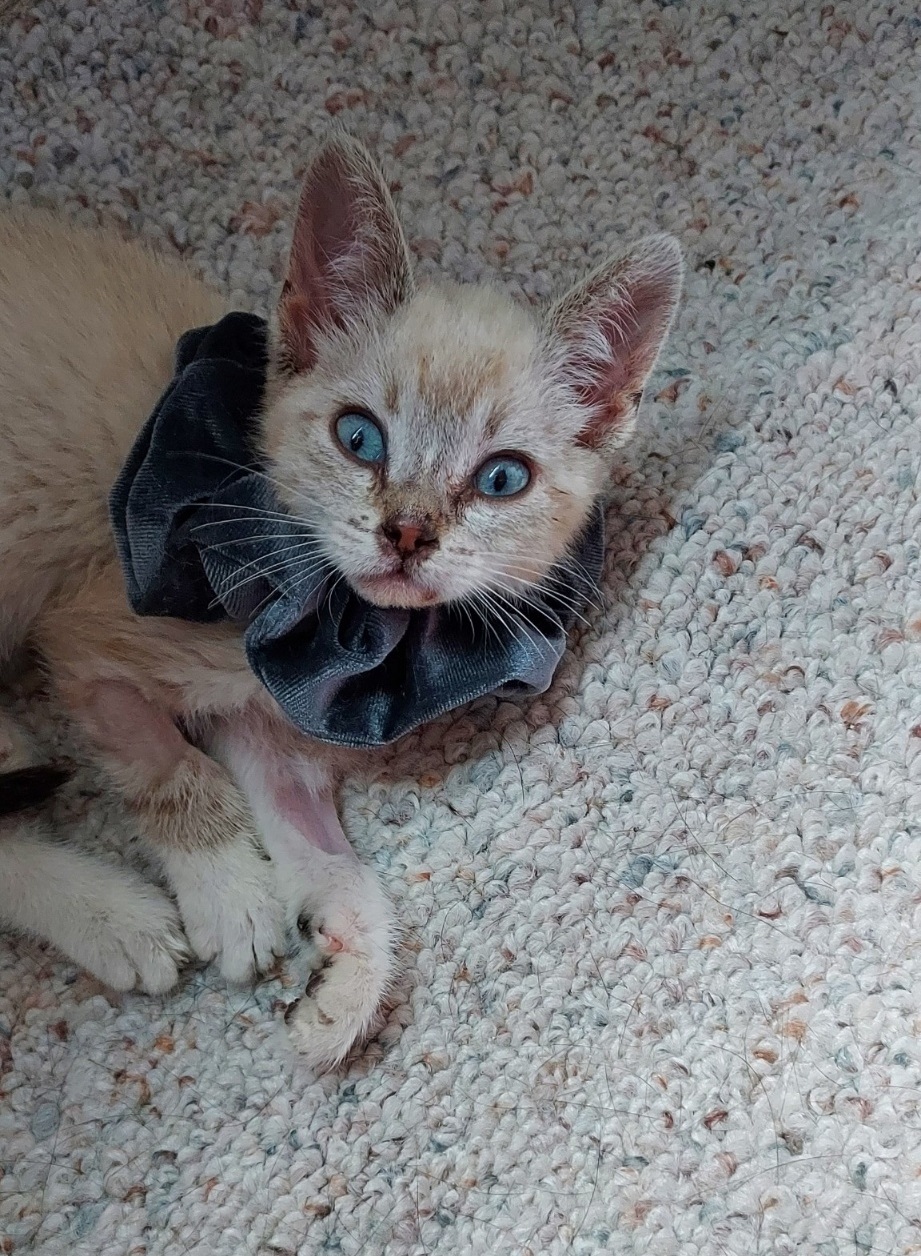
Next up was a foster home for recovery with one of our volunteers. The day after arriving there, he got straight to work purring and making biscuits and was back to eating like a champ. His subsequent checkups showed the repair was holding with no signs of infection or swelling — a best-case scenario!
In the meantime, Salvador’s foster volunteer caregiver called him a “total angel.” Despite all his early trauma, Salvador maintained the best spirit. He was inquisitive, sought attention and couldn’t get enough love. He looked rough at first, but that never stopped him from playing with toys or snuggling with his people or other cats. His foster recalled that the surgical recovery cone was too big, so she used a hair scrunchie. He wanted to be close to people and became an expert at snuggling into necks and licking faces. The other in the home cat took to him immediately, following him around and joining in the cuddles.
When Salvador finally reached 2 pounds, it was time to come back to the Cat Care Society shelter to get neutered and ready for adoption. His foster remembers crying while dropping him off. Despite how much she loved him, she couldn’t keep the sweet little boy, but shared how rewarding it was to help.
Salvador’s neuter surgery went off without a hitch, and this little lovebug found a home very quickly.
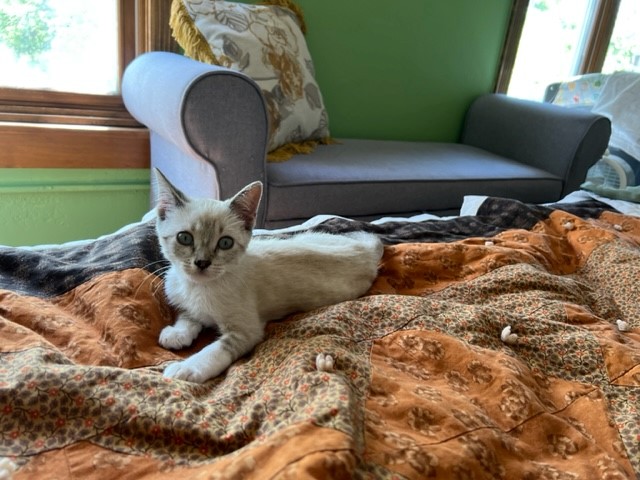
Holly came to us looking for a young, extroverted cat to be a partner for her current 1-year-old cat who had recently lost his other feline friend. We had just the right kitten for her! Upon her first shelter visit, she fell in love with Salvador, and likewise, he chose her, crawling right into her shoulder and offering his signature purrs.
Holly brought him home to the rest of her family in early September of this year. They found out right away how much he likes playing with toys. She took introductions slowly, but once Salvador met resident cat Pickles, it didn’t take them long to become fast friends. They now regularly play together, groom each other and follow each other around like shadows.
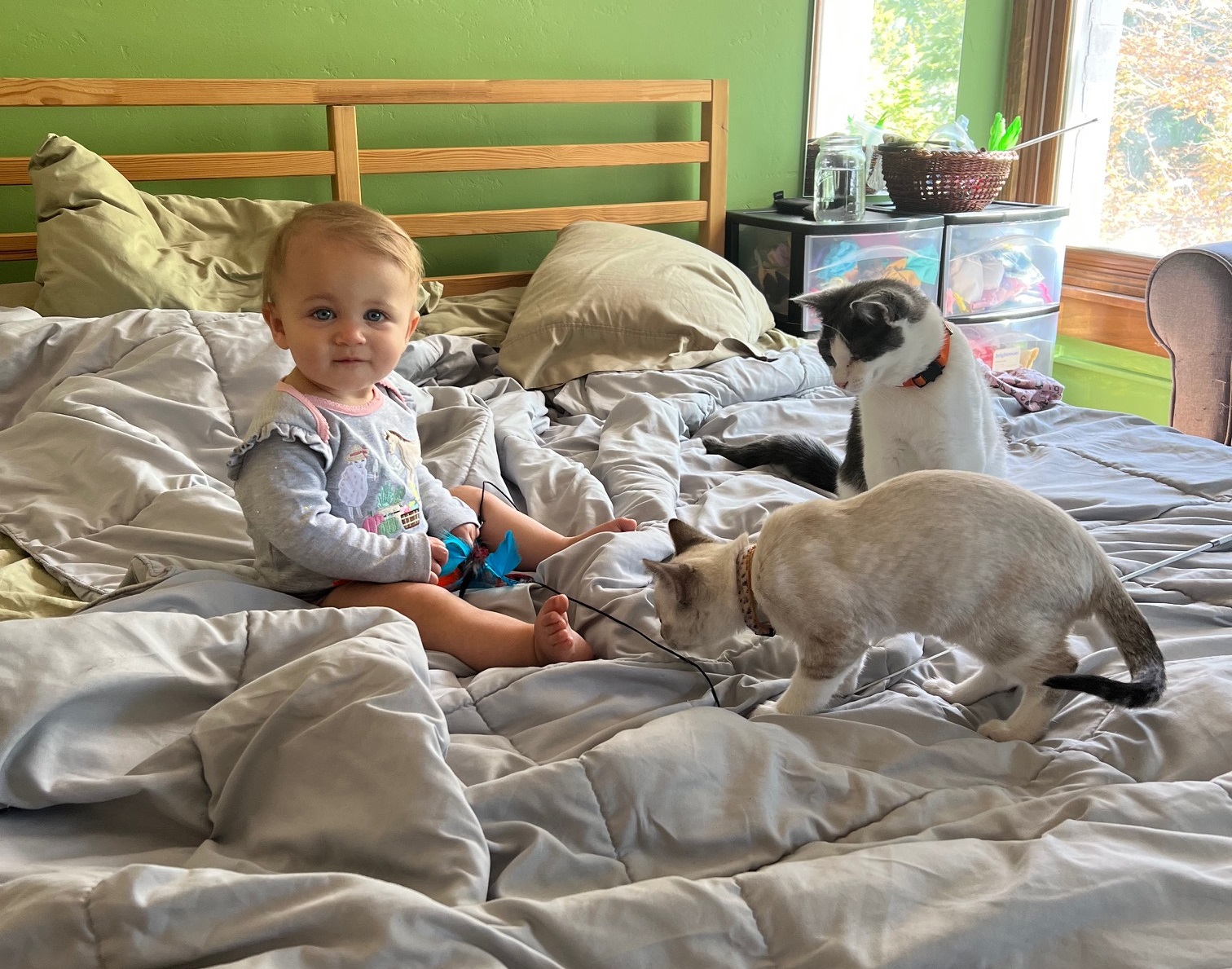
Holly now calls him Dali (like the Spanish painter) and says he’s gotten bigger and has filled out, with zero jaw issues. He is great with her family and other visitors; playful, vocal and just as cuddly as ever. He is easygoing, loves to explore and climb, and receive pets in a chosen human’s lap. He’s smart, too, and knows how to pull toys out of his basket when he’s ready for playtime.
“I like his extroverted personality,” Holly said. “He’s connected to all of us, and was a really good fit. Both Pickles and Dali are thriving and blossoming. Dali gave Pickles a new life.”
Cats like Salvador remind us how much both our foster volunteer and veterinary teams are needed to repair innocent injuries and return a perfect little cat back to health so it has a second chance at life. We need your help to continue our mission of helping all cats on their journeys to finding loving homes. Will you send a financial gift to provide life-saving medical care for cats and kittens just like Salvador?
From the bottom of our hearts and on behalf of the cats, thank you!
With gratitude,
EC Michaels
Executive Director
Cat Care Society
P.S. Cat Care Society receives no government funding and relies 100% on donations from people like you. Donations can be made online, mailed to 5787 West 6th Avenue, Lakewood, CO 80214, or dropped off in person at the shelter.
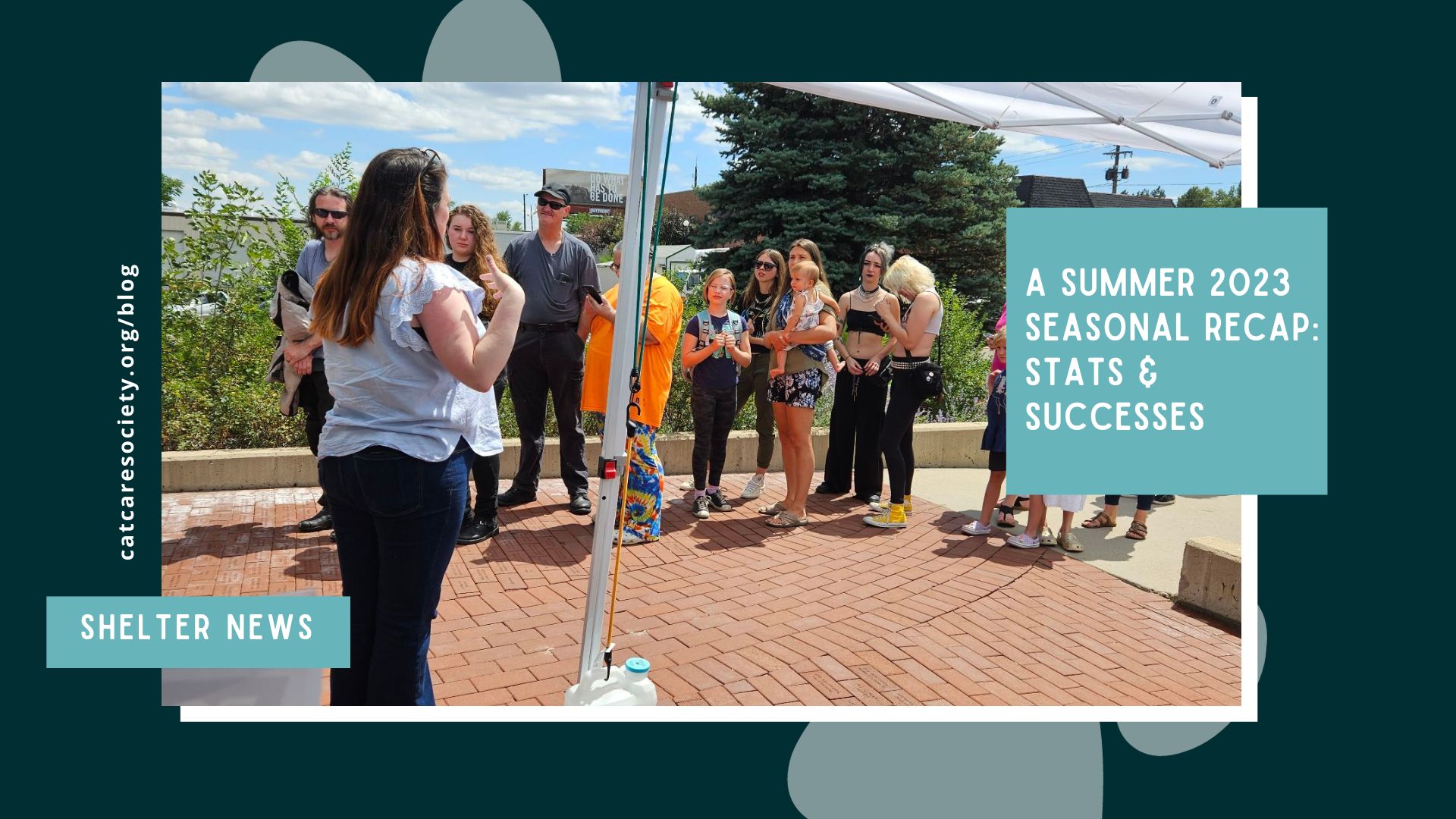
What a summer it was for us here at the shelter. From a very active kitten season to several unexpected surprises and multiple significant and successful events, there were definitely no dull days.
Summer is often the busiest time of year for shelters across the country. Kitten season, aka feline breeding season, typically occurs between late March and October. We see many kittens and momma cats in need during these months, and our incredible fosters take care of the little ones until they are 2 pounds, at which point they can be spayed or neutered and ready for adoption. From April 1 to September 24, 2023, CCS took in 342 kittens. Of those, 258 were adopted and many are still growing in their foster homes!
In August, we hosted a waived-adoption-fee event in honor of Clear the Shelters month, and were overwhelmed at the positive response from our community! That day we adopted out the most cats ever in a single day for our shelter: 31 cats went into loving homes. We also received incredible support from our partner organizations and individuals that ensured the day went off without a hitch. We can’t thank you enough.
We know that there were some concerns over the decision to offer “free” adoptions, and we appreciate the concern for our cats’ well-being. The decision to offer this was made after much discussion and consideration. Please know that we always do our due diligence. All adopters must fill out an application and be approved before bringing any cat home. We want to make sure all our cats end up in loving and committed homes, and we’ll never compromise these values. There have even been multiple studies done by respected animal welfare groups that have found that waived adoption fees do not affect animals’ outcomes in any negative way.
Throughout the month of August in total, we had a total of 132cats come into our care, and we successfully adopted out 141cats. In September, we helped 120 cats — 79 kittens and 41 adults, 13 of which were seniors — find new homes. As we reflect on the prior fiscal year, we also know that we cared for about 400 more cats than the year before. We are so excited to be expanding our ability to help more cats than ever, thanks to your support.
Speaking of stats, I also want to call out a national database called Shelter Animals Count. This platform brings together 6,936 animal welfare organizations to share credible and accessible data to positively impact our animals and communities. Participating in this allows CCS to offer data transparency and greater understanding of cat’s needs across the mountain region. With this knowledge, we can deepen our impact. I encourage you to browse their data to evaluate trends and know that we are supporting these positive outcomes.
I also want everyone to know that my door and phone lines are always open. If anyone has questions or would like any clarification on our statistics, policies or our animals, I would be more than happy to discuss it with you; just reach out!
Over and over again, I am beyond impressed with the dedication our employees, volunteers and donors demonstrate. Every single time we ask for something, someone delivers. I am humbled and so grateful for every one of you who shows up when we need it most. From the bottom of our hearts, thank you.

EC Michaels
Executive Director
Cat Care Society

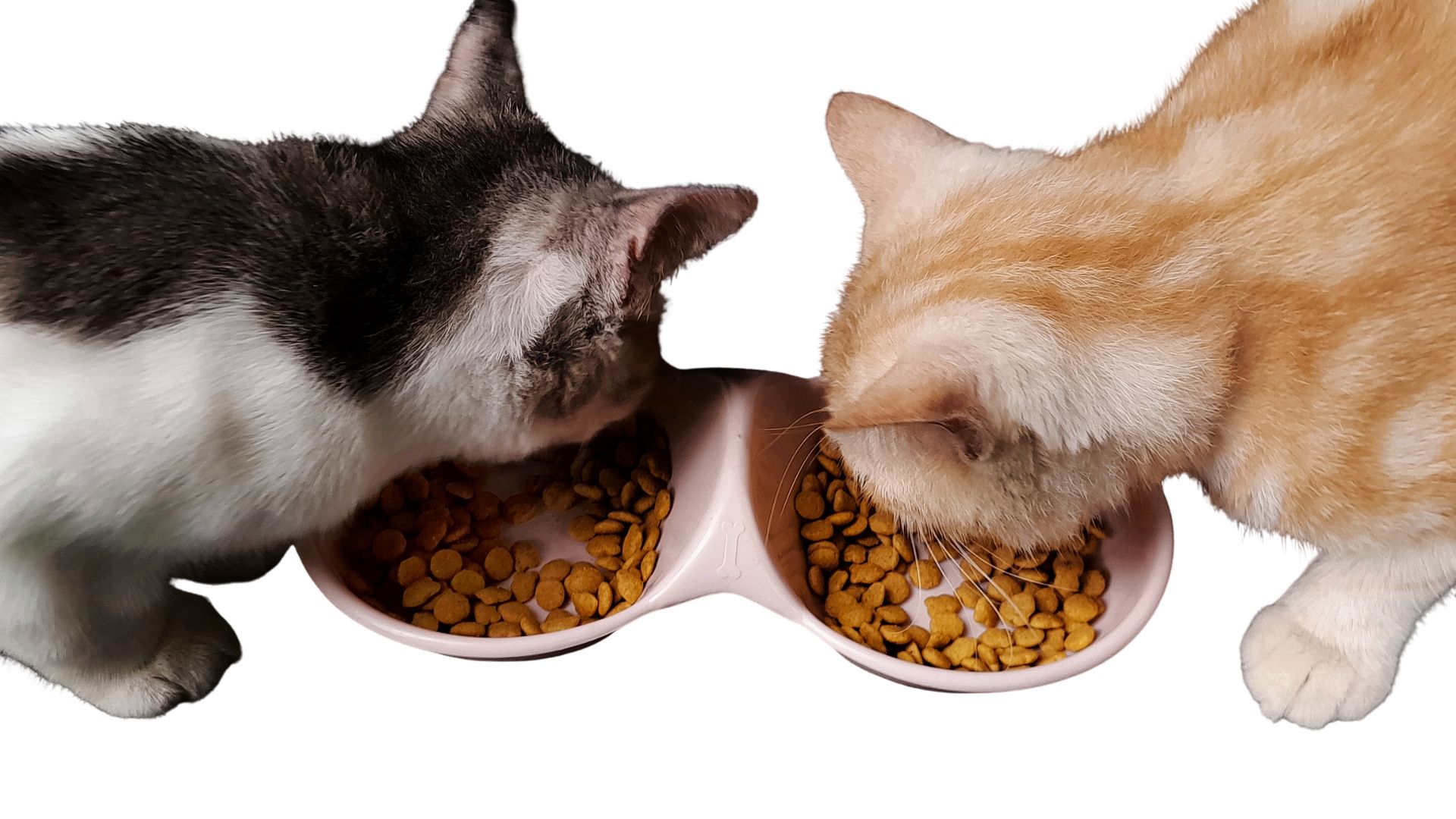
There are more cat food options than ever before, which is great for picky eaters and for cats with special dietary needs, but for a cat owner, navigating the cat food aisle can feel overwhelming. The good news is that with so many options available, even if you’re on a budget, you can still provide your cat with healthy and tasty food. In this article, we will discuss what to look for on the label, pros and cons of various cat food forms, and much more!
The best way to begin filtering through all the cat food options is by knowing what to avoid and what to look for on the product’s label.
What to Avoid:
Food Fact: Terms like “premium,” “gourmet,” “holistic,” “no fillers,” and “human-grade” aren’t legally regulated and don’t guarantee higher-quality ingredients. While foods with these labels aren’t always bad choices, it’s important not to rely solely on these words when choosing a cat food, as they have no official definitions or standards.
What to Look For:
If you’re still having trouble making a decision, you can always ask your veterinarian for suggestions. If your cat needs a specific prescription diet, always follow your veterinarian’s guidance. Also, if you’re adopting a cat, ask the shelter what food the cat has been eating and what they’d recommend. At Cat Care Society, we’re a big fan of Hill’s!
Food Fact: The terms “complete” and “balanced” are defined by AAFCO and are regulated by the Food and Drug Administration (FDA). You can feel confident that when you see “complete” on a cat food, it contains all the required nutrients for a cat. “Balanced” means it contains all the nutrients and they are in the ideal proportions.
Below are the most common forms of cat food. There’s no single perfect choice for every cat, so you may need to experiment to find what best suits your cat’s tastes and your lifestyle.
Dry Kibble: Shelf-stable, cost-effective, and convenient to measure and store, dry kibble is often a significant part of a cat’s diet. There are many options available—from formulas with specific textures to help reduce plaque and tartar, to those fortified with vitamins, minerals, and other specialty ingredients aimed at specific health goals.
Canned/wet food: Containing 70–80% moisture, canned/wet food can support kidney and urinary tract health, especially in cats that don’t drink much water. Wet food is usually very popular with cats, and sometimes essential for cats with dental issues. Some kitties may have a preference between pâté, chunks in gravy, flakes, shredded, etc., so try single cans first before buying in bulk!
Fresh/refrigerated food: This option involves fresh, but cooked, foods that are often steamed to preserve nutrients while reducing harmful pathogens. Safe food handling is still essential to ensure the food remains safe to eat throughout storage and consumption, and be sure to look for complete and balanced options.
Raw/freeze-dried raw food: The goal of commercial raw/freeze-dried raw food is to provide high-quality protein and mimic a cat’s natural prey-based diet. However, most raw cat food products are not complete and balanced, and they also carry a much greater risk of foodborne illness in your pet and in the people living in the household. Additionally, it is not recommended to feed your cat raw meat purchased at a traditional grocery store as it carries a greater risk of illness due to harmful bacteria like Salmonella and E. coli. In recent years, feeding cats raw and freeze-dried cat food has also come with an increased risk of bird flu transmission. The Food and Drug Administration (FDA) has some great research and guidance on raw pet food diets.
Many cats enjoy a combination of foods. This could look like mixing dry food in with a wet pâté at meal time or serving them separately, such as wet food in the morning and dry kibble for their evening meal. The most important thing is to choose foods with a nutritional adequacy statement on the label, which confirms they are complete and balanced and meet AAFCO nutrition standards.
One thing is for sure: cats need meat. Cats are obligate carnivores, which means they need to eat meat to stay healthy. In general, cats do best eating a diet with high amounts of protein, moderate amounts of fat, and minimal amounts of carbohydrates. Check out our blog post that goes into more detail on why cats need to eat meat to learn more!
Food Fact: Each cat is unique, and their dietary needs are unique, as well. General recommendations given in our blog or on the food products you purchase may not be the best fit for your cat. We always recommend consulting your veterinarian when deciding on the best types and amount of food to feed your cat daily.
Whatever you call them, choosy cats can make it difficult to find that balance of nutritious, delicious, and budget-friendly. A good place to start is by switching up the consistency and texture, because a cat’s senses are especially sensitive to it. From having a jaw designed for shearing meat and crunching bones to having highly sensitive whiskers and lips, they notice the subtle differences in food shape, size, and feel. For example, certain cats may love shredded wet food in gravy but stick up their noses to chunks in gravy. Below are some ideas to satisfy your feline foodie.
When to Visit a Vet: If you notice a sudden change in your cat’s food preferences, it’s a good idea to visit your veterinarian to rule out any new health conditions or dental issues. Additionally, if you notice your cat excessively scratching, licking, or biting their skin, it may indicate that they have a food allergy.
By paying attention to the label and choosing foods that meet AAFCO standards for your cat’s life stage and health needs, you can ensure your cat gets the nutrition they need. Remember that different forms of cat food—dry kibble, wet/canned, raw/freeze-dried, or fresh/refrigerated—each have their benefits, and many cats thrive on a mix. For picky eaters, experimenting with texture, temperature, and food enhancers can make mealtime more enjoyable.
Donate you extra cat food to CCS! If you have leftover cat food that your cat doesn’t enjoy or food you simply no longer need, consider sharing it with other cats. CCS gladly accepts any non-refrigerated, unexpired cat food or treats—wet or dry, new or partially used (in their original packaging). Simply bring your donations during shelter hours and leave them in the designated donation area in the lobby.
About the Author: Beth Dokolasa is a volunteer for Cat Care Society and serves on the Board of Directors. She is an instructional developer for Natural Grocers and lives in Indian Hills, Colo., with her husband, daughter, and two cats, Techno and Digit.

When Sunny came to Cat Care Society, she was heartbreakingly fragile. This petite brown tabby faced some of the toughest medical challenges we see in cats: advanced kidney disease, severe anemia, constant vomiting, and dangerous weight loss. Each day, her future seemed uncertain.
But even when she was weak, she never stopped showing us her sunny disposition. She purred through exams and headbutted our staff’s hands as if to say, “Don’t give up on me.”
And we didn’t.
Sunny quickly became a staff favorite at Cat Care Society. That’s why we gave her a special distinction: the “Lonely Hearts Club.” This group is reserved for cats who need a little extra help to find their perfect match — older cats, those with longer stays, or cats facing complex medical needs. Sunny ticked every one of these boxes, but we knew she deserved the chance to find a home where she could feel safe and loved.
To continue receiving the daily medications, fluids, lab work, and constant care that keep cats like Sunny alive, we rely on support from donors like you. Every lab test, every dose of medicine, every gentle pat from our veterinary team is only possible because someone chose to give.
Most importantly, generosity from donors like you gave her the greatest gift of all: time. Time to grow stronger, stabilize, and wait for someone who would open their heart to a 14-year-old cat with lifelong medical needs and costly care.
After five months of care in the shelter, Sunny met her perfect match. A local veterinarian met Sunny and instantly knew they were meant to be together. Able to provide the ongoing medical attention Sunny so desperately needed, she was able to give Sunny a loving and restorative home to live out her golden years.
“Sunny (now called Cardi) is doing great! She is a very sweet girl, loves pets and cuddles, and has adjusted well. Her kidney disease is also doing well, her anemia is holding steady, and her weight has continued to go up. I love senior kitties and helping them feel the best they can by managing any medical issues.” – Dr. Hale, Sunny’s adopter

At Cat Care Society, every cat’s care is guided by a compassionate and expert approach — combining veterinary protocols, staff training, donor-funded medical treatments, and specialized initiatives like the Lonely Hearts Club. Sunny’s recovery was not a one-time miracle, but the result of this proven approach designed to identify, treat, and advocate for our most vulnerable feline friends.
Today, Sunny is no longer a lonely heart. She is safe, cherished, and adored — thanks to supporters like you.
But while Sunny’s story has a happy ending, many other Lonely Hearts are still waiting at Cat Care Society. Senior cats. Cats with medical challenges. Cats who have been overlooked time and again. They are counting on us, and on you, to give them love, care, and a second chance at life.
Will you open your heart today to help the next lonely heart find their loving home? Your gift provides the medications, veterinary care, and loving support that make happy endings like Sunny’s possible.
With gratitude,
– EC Michaels
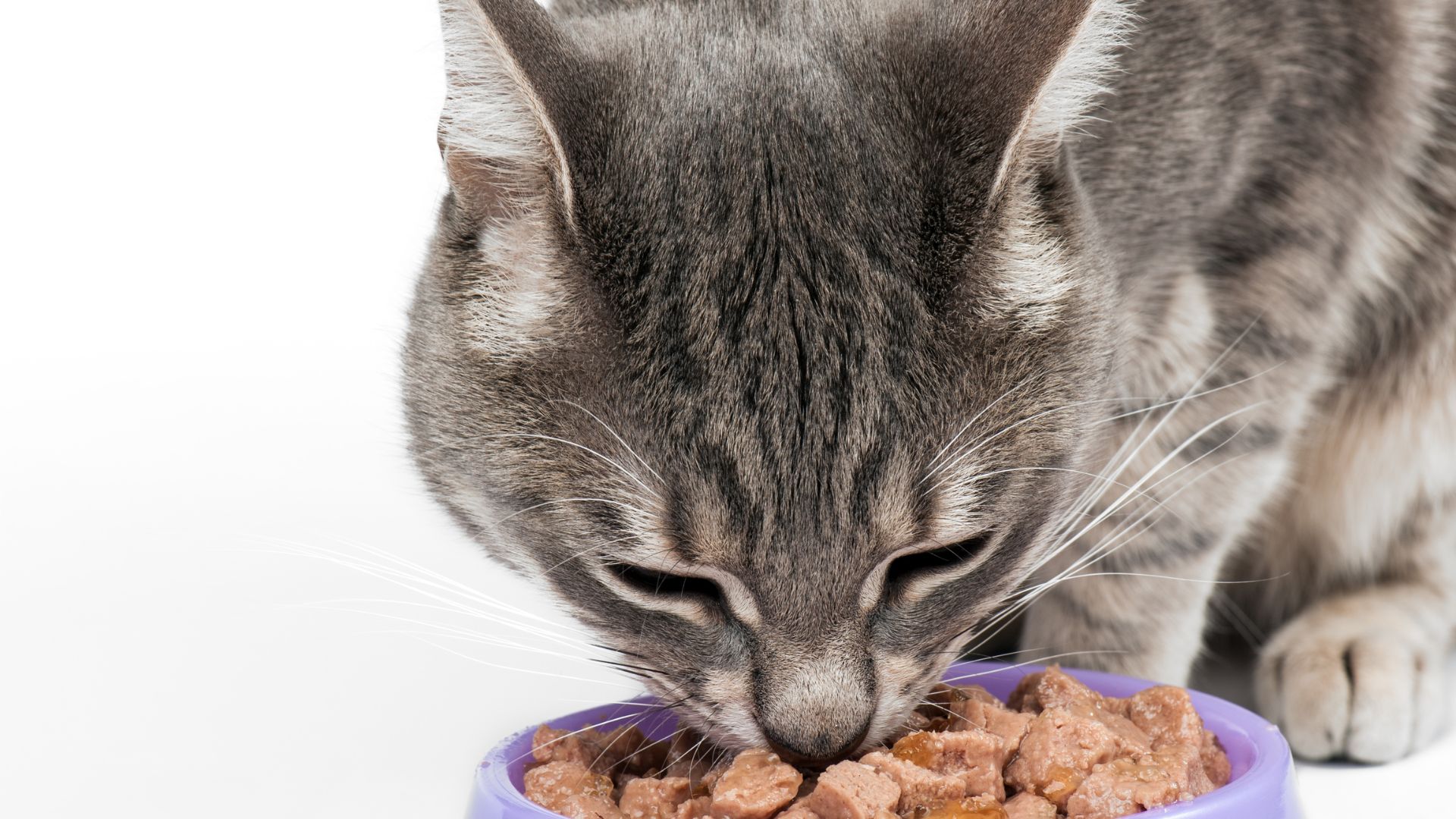
Cats are often known for being picky eaters—whether it’s an aversion to certain kibble shapes, a preference for pâté over chunks in gravy, or a liking for food served slightly warmed. For cat owners, finding a food that their cat enjoys while still meeting nutrition needs can be a real challenge. However, one thing remains certain: cats are obligate carnivores and need to eat meat.
An obligate carnivore is an animal that must eat meat to survive because its body is biologically adapted to derive essential nutrients solely from animal-based sources. Cats evolved as hunters that consume prey containing high amounts of protein, moderate amounts of fat, and minimal amounts of carbohydrates, and they still typically do best consuming those proportions today. Just like humans, cats also require certain amounts of micronutrients, like vitamins, minerals, and amino acids to thrive.
Cats require many kinds of micronutrients from a variety of sources. Below are some of the key nutrients that are either exclusively found in meat or for which meat is the best source.
Without adequate intake of these vital nutrients, cats can experience deficiency symptoms and even irreversible damage to their health, so it’s important to provide them with a complete and balanced diet that reflects their biological need for meat-based nutrition.
Food Allergy Note: Even though cats need meat, they can still develop allergies to certain kinds of meat. The most common meat allergens for cats are beef, chicken, and fish. If you regularly feed these to your cat and notice them scratching, licking, or chewing themselves more than usual, they may have a meat allergy. Your cat’s veterinarian may recommend an elimination diet trial where you avoid the foods they regularly eat for a designated time to see if the symptoms improve. Alternative meat protein like rabbit, duck, and venison are often good options for cats with known meat allergies.
If you’re starting to think this is all leading to a time-consuming recommendation for homemade, all-meat meals—don’t worry. Regardless of quality, feeding your cat only prepared muscle meat (such as chicken breast or ground turkey) can actually lead to essential nutrient deficiencies! Cats need a variety of nutrients found in organ meat and animal fat, too. For balanced and complete nutrition, cats typically do best consuming commercially balanced raw and cooked food.
Look for products that contain a nutritional adequacy statement on the label. This indicates that the food meets the nutritional standards set by the Association of American Feed Control Officials (AAFCO), a nonprofit that establishes nutritional standards for pet foods. Cat Care Society is a proud partner of Hill’s Food, Shelter & Love program, and we feed Hill’s to our shelter cats. Hill’s recipes meet AAFCO nutrition standards, so our cats get the complete and balanced nutrition they need. (Note: AAFCO does not directly test or certify pet foods. Pet food companies use third-party testing agencies to analyze their foods according to AAFCO guidelines.)
Supplemental homemade meals can often be included as a part of your cat’s healthy diet, provided that it’s approved by the cat’s veterinarian, safely prepared, and does not include any ingredients harmful to cats, such as garlic, onions, raw eggs, and excess sodium. Additionally, do not feed your cat raw meat. While cats eat raw meat in the wild, feeding them raw meat purchased at a traditional grocery store can cause illness due to harmful bacteria like Salmonella and E. coli.
Understanding your cat’s biological need for meat is essential to supporting their lifelong health and well-being. As obligate carnivores, cats rely on meat not just for protein, but for critical nutrients like taurine, arachidonic acid, and essential vitamins that they cannot make on their own. By choosing high-quality commercial foods that meet AAFCO standards and consulting with your veterinarian, you can feel confident that you’re giving your cat the nourishment they need to thrive.
About the Author: Beth Dokolasa is a volunteer for Cat Care Society and serves on the Board of Directors. She is an instructional developer for Natural Grocers and lives in Indian Hills, Colo., with her husband, daughter, and two cats, Techno and Digit.
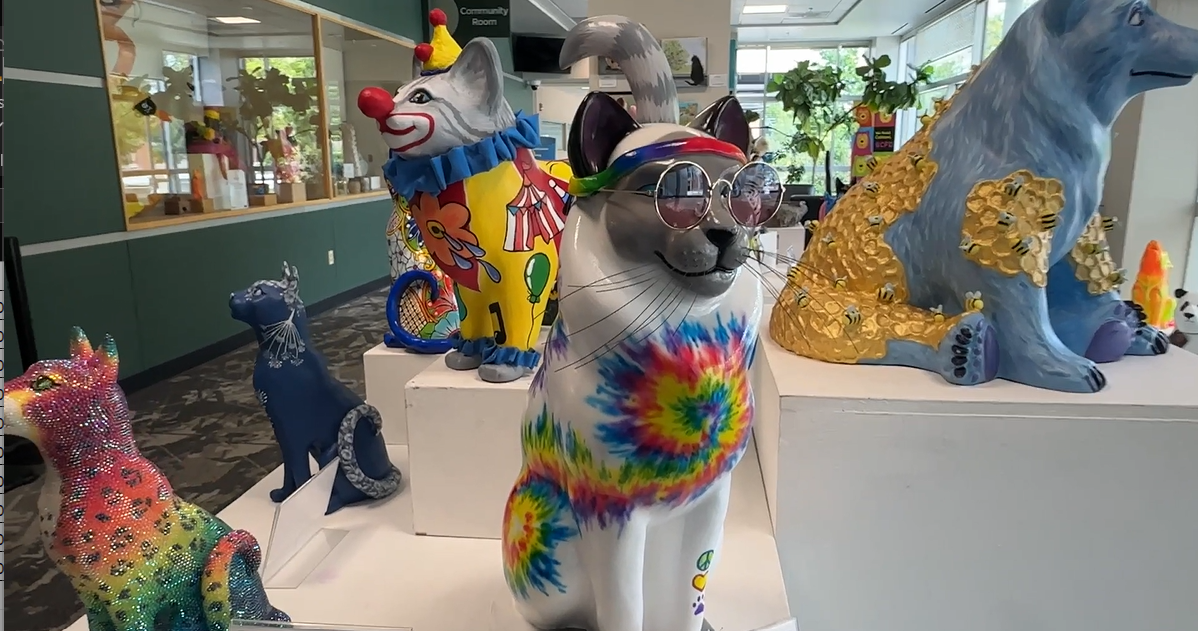
Cat Care Society is proud to announce 29 local artists selected for the 2025 “Tails of the Painted Cats” (TOPC) exhibition. These Colorado creatives have each transformed fiberglass animal sculptures into stunning, one-of-a-kind works of art, now on public display and set to be auctioned this fall to benefit the shelter’s life-saving programs.
Now in its tenth year, Tails of the Painted Cats has become CCS’s signature fundraiser and a beloved event in the Denver arts community. The event brings together artists, animal lovers, and supporters to celebrate compassion through creativity.
“What began as a small, unique fundraiser has grown into a cherished tradition,” said Cat Care Society Executive Director EC Michaels. “As our largest fundraising event, every ticket, bid, and vote truly makes a difference, supporting critical medical care, enrichment, and safe housing for the more than 1,000 cats who come through our shelter each year.”
Seventy-five artists applied for this year’s collection, of which 29 were selected to create animal sculptures. The sculptures are currently on tour.
This year’s exhibition includes:
|
|
“It’s been an incredible joy to watch this event grow over the years,” said Jane Dorsey, Cat Care Society’s longtime Art Director. “This year’s collection is one of our best yet—full of creativity, love, and spirit.”
Tara Deenihan, Art Coordinator and incoming lead for the program, added: “The artists participating this year have truly blown our minds! We have several new artists and many returning artists, and seeing their ideas come to fruition has been really exciting. The cats are all so different and beautifully realized – I love seeing what cats can inspire.”
The public is invited to view the sculptures in person or online and vote for their favorite in the People’s Choice Award. The winner will be announced at the TOPC gala on October 18, and the artist will receive a cash prize.
This year’s TOPC gala will take place Saturday, October 18, 2025 at Pinehurst Country Club and will be masquerade themed. 9News Reporter, Steve Staeger returns as this year’s emcee. Tickets will go on sale in mid-June.
Learn more about Tails of the Painted Cats at catcaresociety.org/topc/
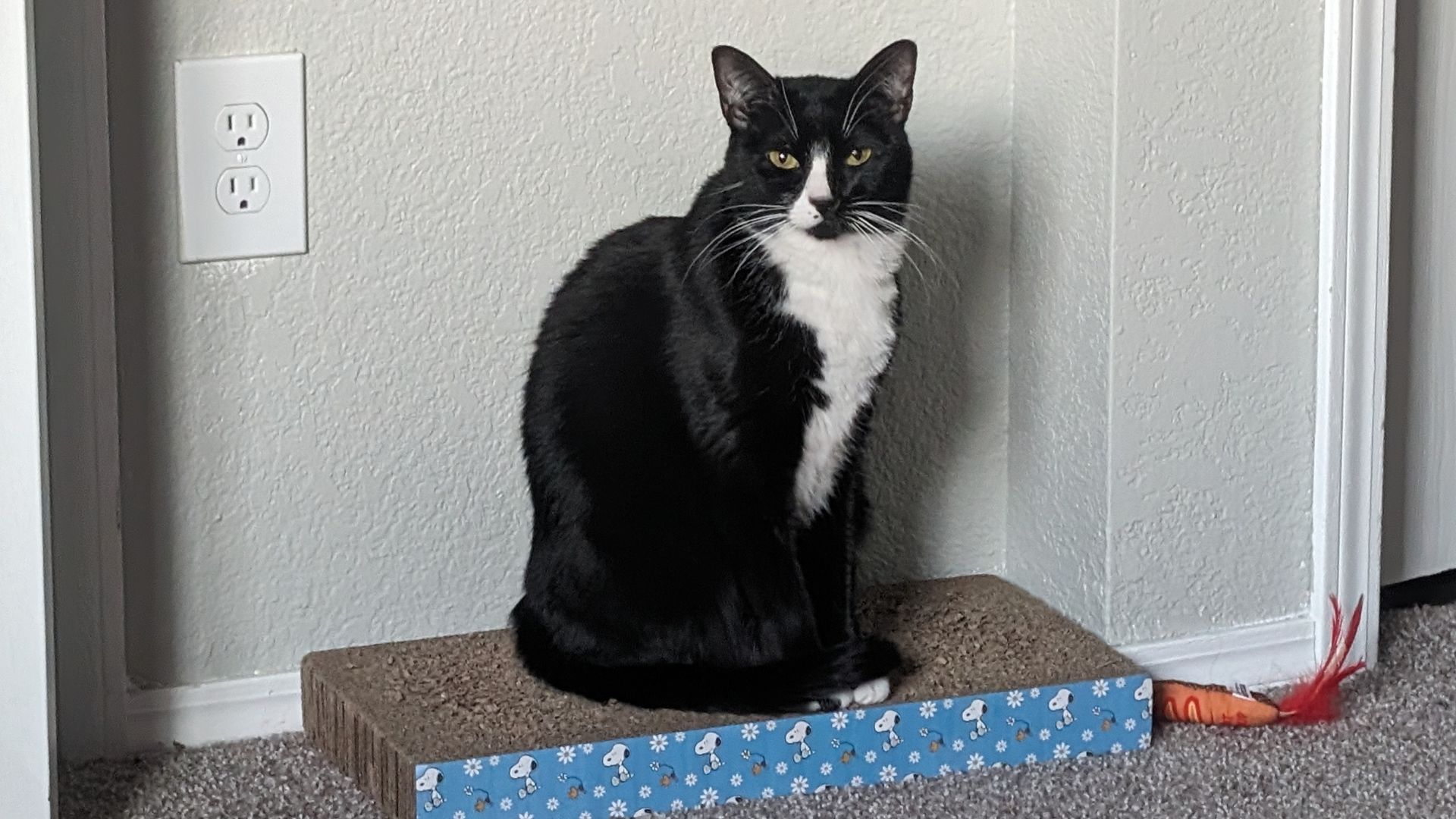
At Cat Care Society, we know that caring for cats is a team effort—and one of the most important parts of that team is our foster network. While our shelter provides safe, dependable housing and veterinary care for hundreds of cats each year, foster homes offer something we can’t always replicate within our walls: a quiet, individualized space where certain cats can truly thrive.
Foster homes complement the work shelters do. They enable us to have a flexible and responsive system that helps more cats heal and grow, and they allow us to stretch our resources further, provide individualized support to vulnerable cats, and ultimately increase each cat’s chances of getting adopted.
Below are just a few of the ways that foster homes support shelters and countless cats, both directly and indirectly!
Shelters provide a lifesaving refuge for cats, offering medical care, nutrition, protection, and enrichment. But for certain cats, especially those with special needs, a home environment can offer extra support that helps them recover, adjust, or grow in ways that a busy shelter environment might not allow.
Foster care can be beneficial for:
These cats benefit from one-on-one attention and a stable environment where they can relax and show their true personalities.
Foster care expands a shelter’s capacity. Every cat that goes into a foster home opens up space in the shelter for another animal in need. This is a critical part of how shelters operate, especially during busy seasons when intake numbers rise.
Fosters also allow shelters to:
Foster care is not a separate system—it’s part of CCS’ toolkit, allowing us to stretch our impact and offer flexible, creative solutions when cats need them most.
Cats in foster care often show their true personalities more readily than they might in a shelter. This helps CCS provide more information to potential adopters get a clearer sense of whether a cat is the right fit for their home.
Foster homes play a critical role in:
The result? Cats who are more confident, better understood, and great candidates for adoption!
Strawberry (shown at the top of this post) came to CCS as an extremely fearful cat who demonstrated this fear with aggression. We’re talking about spitting, hissing, growling, and lunging at CCS staff, completely unprovoked. A medical workup ruled out any underlying medical conditions that could be contributing to the behavior. Strawberry was a great candidate for a quiet foster home where she could have space, get comfortable, and work on socialization at her own pace.
In just over a week, a report from the foster stated that Strawberry had become a lap cat, was accepting and demanding pets, and had begun giving “head boops” or bunting, which is one way cats show affection. The foster was also able to quickly pick up on Strawberry’s motivations, favorite toys, and preferred ways to receive pets which accelerated Strawberry’s comfort level and ability to socialize. With patience and gentle care, Strawberry came out of her shell and built a lot of confidence.
After just under two months in the foster home, Strawberry came back to the shelter and was adopted a short time later!
At Cat Care Society, we’re proud to offer a safe, well-equipped shelter environment for our cats. But we also recognize that cats, like people, have individual needs. Foster homes allow us to meet those needs with compassion and flexibility.
Foster homes don’t replace shelters—they enhance them. Together, we’re able to give each cat the kind of care that works best for them. Whether it’s a cat recovering from surgery, a shy kitten learning to trust, or a beloved pet temporarily staying with us while their owner gets back on their feet—foster care gives us options. And options save lives and produce the best possible outcomes.
We’re incredibly grateful for our foster caregivers and the role they play in this mission. Because of them—and in partnership with our shelter—we’re able to do more, reach farther, and help every cat get one step closer to home.
Foster homes are the quiet heroes of the cat rescue world. They don’t just provide temporary shelter—they provide special cats opportunities to heal, grow, and shine. Their impact can’t be overstated: they help shelters run more effectively, improve outcomes for individual cats, and create a more compassionate, responsive animal welfare system.
At Cat Care Society, we are deeply grateful for every person who opens their home to a cat in need. If you’re interested in becoming a foster, please apply! We’re especially looking for fosters willing to take in cats with medical needs, those needing behavioral support, mother cats with litters, and young kittens. CCS provides all necessary training and support, including costs for your foster cat’s needs from food to medical care.
About the Author: Beth Dokolasa is a volunteer for Cat Care Society and serves on the Board of Directors. She is an instructional developer for Natural Grocers and lives in Indian Hills, Colo., with her husband, daughter, and two cats, Techno and Digit.
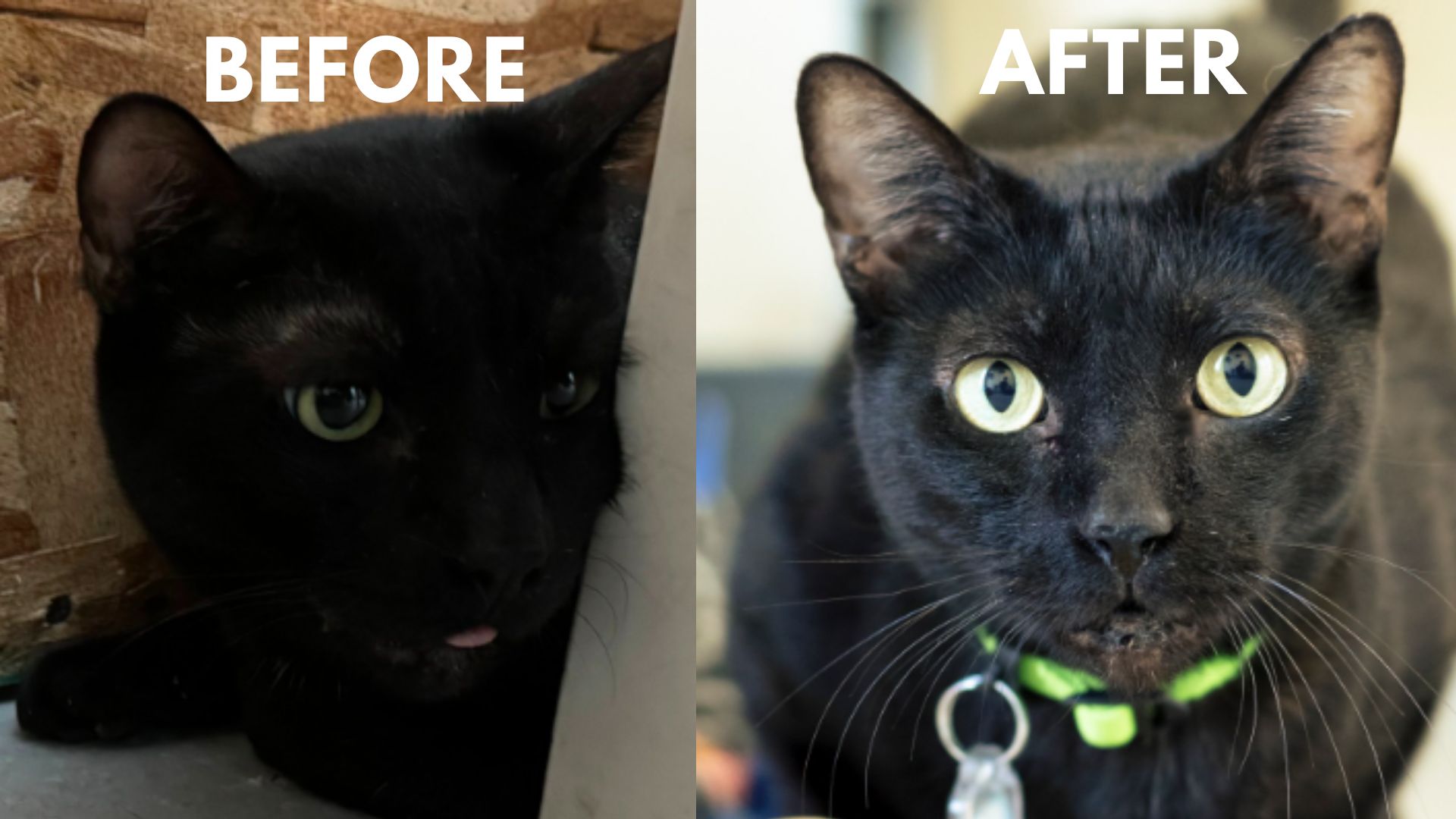
When I walk into Cat Care Society, or any shelter, with my camera, I don’t see homeless pets – I see stories waiting to be told.
I see cats with beautiful personalities just waiting to come out once they find the right person. Some are shy and mysterious, others sassy or playful, but they all have one thing in common: they deserve to find that Right Person. We live in a world where adoptions begin with a scroll on a screen, where the very first impression is what makes a connection, where love at first sight is very real.
That’s where photography comes in. They need not just any photo, but one that speaks err …MEOWS.
Online pet profiles are now often the first step to adoption. A great photo can stop someone mid-scroll, make a potential adopter feel something, and highlight a pet’s unique spirit with their eyes, their head tilt, and their expressive tail.
Think about it this way – would a blurry photo of a dark shadow stop your eyes from scrolling? Or would you instead pause on a well-lit portrait of a clear-eyed feline looking through the phone directly into your soul?
Images like these invite a second look. And that second look can turn into love.
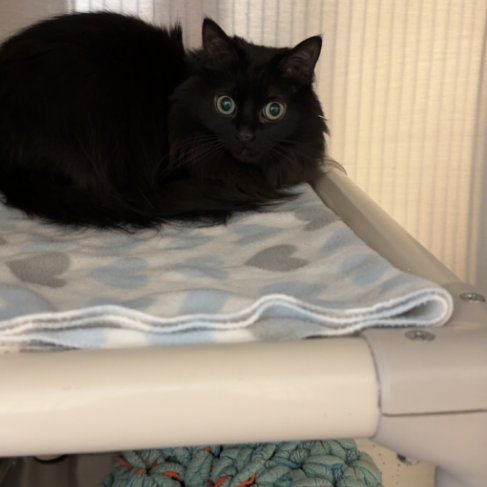
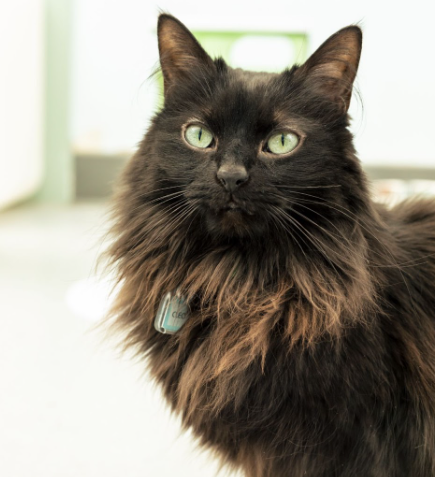
By the time I get to them, most of these cats have had enough days to settle into their new surroundings. Their original intake photo is usually taken just as they arrive. They’re not sure where they are or who these strange people are and it shows. After a few days, most have realized they’re safe. They’ve gotten some sleep, maybe some treatment, delicious food, they generally feel better, and that also shows.
Cleo, as you can see from the intake photo versus the portrait, was all about asking me for attention when I came in to photograph her. Her royal line was becoming obvious! And since then, she has been adopted into a loving family.
While I love volunteering my professional photography for Cat Care Society and others, I know many fosters are doing amazing work on their own — and you want your foster cats to stand out, too.
The next time you see an adoption profile, take a second to really see the cat. If you feel drawn in by the photo – even if just for a moment – know that was no accident.
It was love, caught in a frame.
Susie Inverso owns Crimson Cat Studios Pet Photography in Lakewood, CO. She specializes in capturing the true spirit of companion animals through compassionate, story-driven portraits. You can learn more about her at www.crimsoncatstudios.com
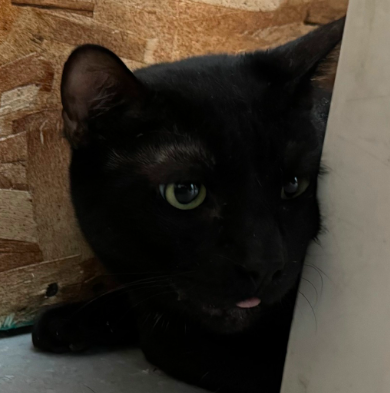
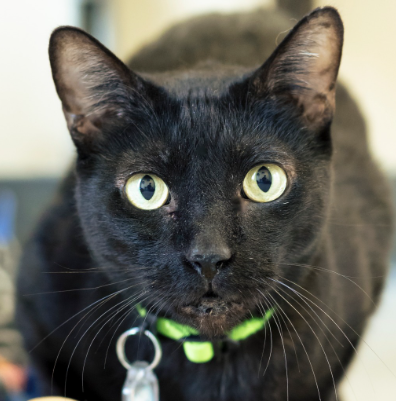
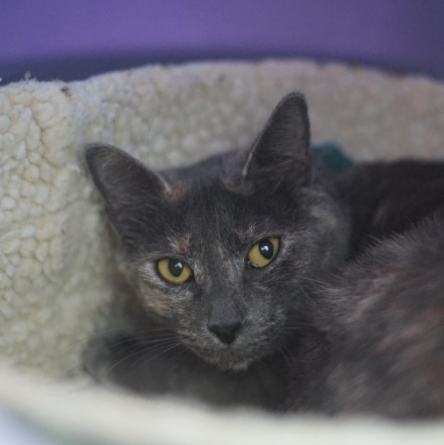
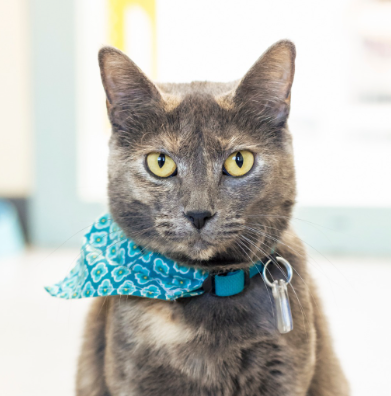
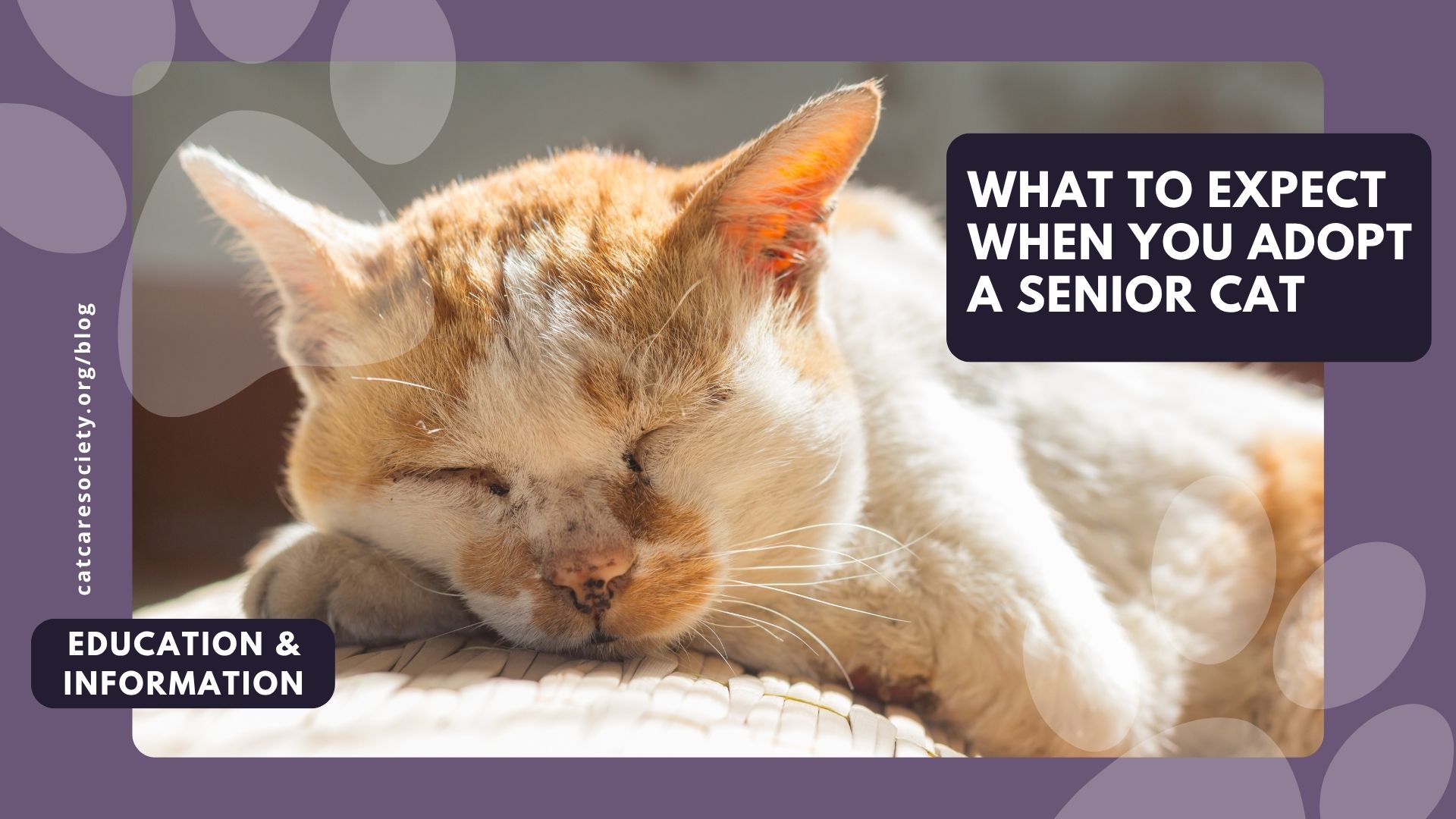
Cat Care Society believes that all cats are worthy, regardless of their age or abilities. Senior cats, in particular, hold an extra special place in our hearts—and it’s not just us! Time and again, we hear from adopters who submit successful adoption updates that feel the same way. Senior cats are sometimes overlooked in shelters, but those who choose to adopt them often say it’s extremely rewarding and they’re amazed at the quick and deep connections they make.
While every senior cat is unique and has their own personality, there are some common things you can expect and prepare for when you adopt a senior cat, which we’ll share later in this article.
Unlike humans, cats don’t start receiving AARP letters in the mail to let them know they’re considered a senior, but they do often show their age in subtle ways, through their physical health and behavior. Cats typically enter the senior category at age 10, which is when their nutritional and wellness needs begin to shift. However, some veterinarians begin senior wellness exams as early as age seven to help catch potential health concerns early.
Like humans, cats can age prematurely due to lifestyle factors such as lack of nutrition, trauma or injury, and lack of preventative veterinary care. When a cat’s history is unknown—as is often the case with strays and other cats seen in shelters—veterinarians rely on indicators such as the condition of their teeth, skin, coat, eyes, and mobility to estimate age.
Below are some common, but often unexpected, traits and tips from senior cat households.
Because older cats have lived longer and likely experienced highs and lows, they recognize when they’ve got it good! When you bring a senior cat into your home and provide them with a cozy bed, stable routine, and tasty food, they are more than happy to show their gratitude and appreciation. Whether it’s slow blinks, sweet head bumps, or deep purring, senior cats have their own gentle ways of expressing love and appreciation.
Along with a special diet, senior cats may require ongoing medication, depending on the health condition. Fortunately, just like other habits, such as always escorting you to the bathroom or meowing loudly if their mealtime is even one minute late, cats can also get into the routine of taking their medicine. When you adopt a cat with a health condition from Cat Care Society, you’ll receive guidance on what foods and treats may be most appropriate for your new cat, as well as instructions on how to administer any required medication to set you both up for success. For cats requiring specialized ongoing care, we may have you meet with our veterinary team before completing the adoption to ensure you understand your new pet’s medical needs, feel confident transitioning them to your home, and have all the information you need to continue care with your preferred veterinarian.
Opening your home to a senior cat means offering love, comfort, and stability when they need and appreciate it the most. Plus, the bond and companionship you’ll share can be incredibly rewarding.
At Cat Care Society, we know how special older cats are, and we’re here to support you every step of the way. Whether you’re a first-time adopter or an experienced cat parent, we invite you to consider the joy of bringing home a senior cat.
Please note that the traits we’ve shared are common among senior cats, but not guaranteed. Your new feline friend may have their own quirks and needs based on their personality and life experiences.
When browsing our cats available for adoption, you can filter by age group (see image below) to easily find your perfect senior friend. Many of our older cats are members of our Lonely Hearts Club, a group of special cats chosen by CCS staff to spotlight those who have been overlooked in the past, despite their potential to thrive in the right home. No matter their past experiences, a senior cat’s next chapter with you could be the most meaningful.
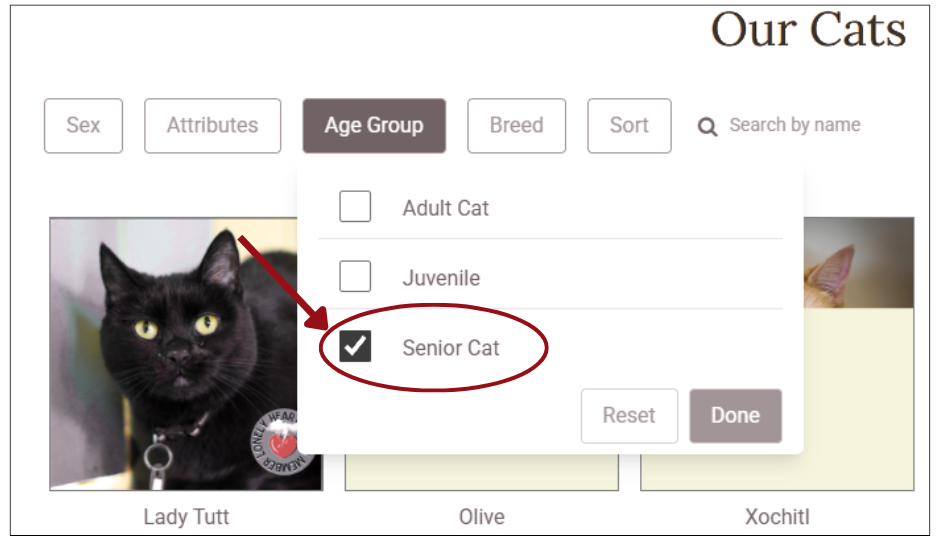
About the Author: Beth Dokolasa is a volunteer for Cat Care Society and serves on the Board of Directors. She is an instructional developer for Natural Grocers and lives in Indian Hills, Colo., with her husband, daughter, and two cats, Techno and Digit.
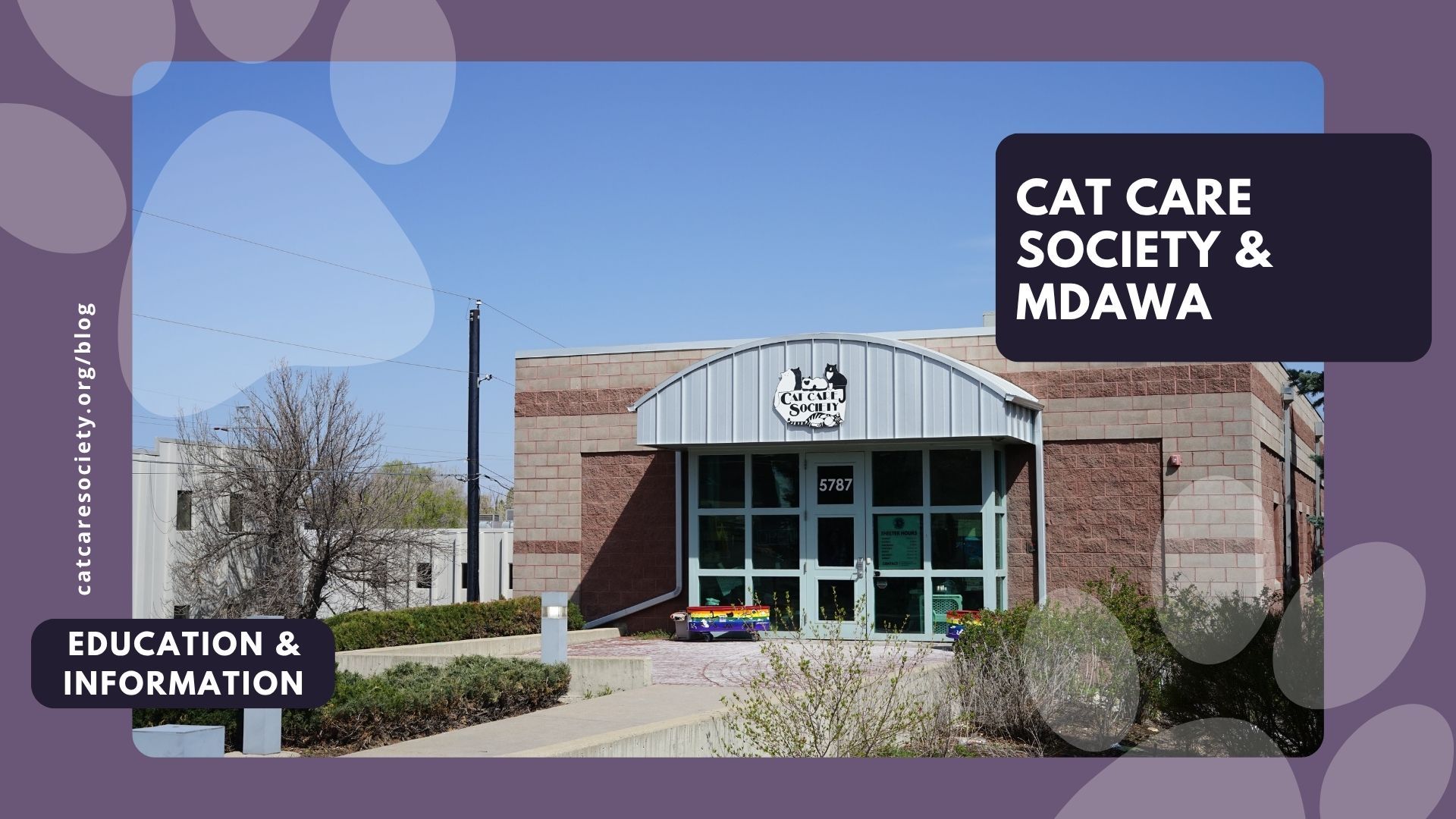
Cat Care Society is a proud member of MDAWA, the Metro Denver Animal Welfare Alliance. This coalition of 20+ local shelters, rescue groups, and animal service providers work together to promote humane care for companion animals in our community.
At Cat Care Society, collaboration with other shelters is imperative to our mission. Over half of the cats who come to our shelter are transferred from other shelters or rescues who don’t have the resources to support the needs of these special cats.
Ready to adopt a cat in need? Check out this helpful adoption guide from MDAWA (along with our answers!).
Before You Adopt a Pet: What to Know and Ask
Adopting from a Metro Denver Animal Welfare Alliance (MDAWA) Member Means Adopting with Confidence
Adopting a pet is one of the most rewarding decisions you can make—but it’s also a big commitment. Choosing the right adoption organization is just as important as finding the right animal. When you adopt from a member of the Metro Denver Animal Welfare Alliance (MDAWA), you’re supporting a network of organizations that are dedicated to ethical, compassionate, and community-focused animal welfare.
MDAWA members aren’t just placing pets—they’re committed to being your long-term partner. Here’s how they go above and beyond, and what to ask when you’re considering adoption.
They’ll Be Your Long-Term Animal Welfare Partner
MDAWA organizations understand that adoption is just the beginning of your journey with a new pet. They offer resources and support to help adopters navigate any challenges that may come up after adoption—ensuring the best outcome for both you and your pet.
They Work with You to Make the Right Match
Rather than rushing the adoption process, MDAWA members take the time to make thoughtful, informed matches. They consider your preferences, lifestyle, experience, and the specific needs of the animal to help ensure a successful, lasting connection.
They Prioritize Animal Health and Wellness
All animals adopted through MDAWA organizations receive thorough medical care before adoption. This includes vaccinations, spay or neuter surgeries, and other needed veterinary treatment. They also provide behavioral support, so pets are set up for success in their new homes.
They Help the Most Vulnerable Local Animals
MDAWA members focus on protecting the Denver Metro area’s most vulnerable animals—those who are stray, surrendered, or at risk of homelessness—rather than bringing in only easily adoptable animals from out of state.
They Work Together to End Pet Homelessness
These organizations collaborate to provide a wide range of services that benefit the community, such as lost-and-found programs, low-cost veterinary care, spay/neuter clinics, and pet food pantries. By supporting a MDAWA member, you’re also supporting efforts to reduce the number of homeless animals in your neighborhood.
When you’ve found a pet you’re interested in, it’s a good idea to ask the organization a few key questions to make sure you’re adopting from an ethical, responsible source. Here’s a checklist to guide you:
By carefully choosing where you adopt, you can ensure your new pet has been well cared for and is a good fit for your family. When you adopt from a MDAWA member, your decision not only changes a pet’s life—it also supports a network of organizations working together for ethical animal welfare across the Denver metro area.
Consider adopting your next pet from a MDAWA member.
Learn more about our mission and our members at mdawalliance.org/about
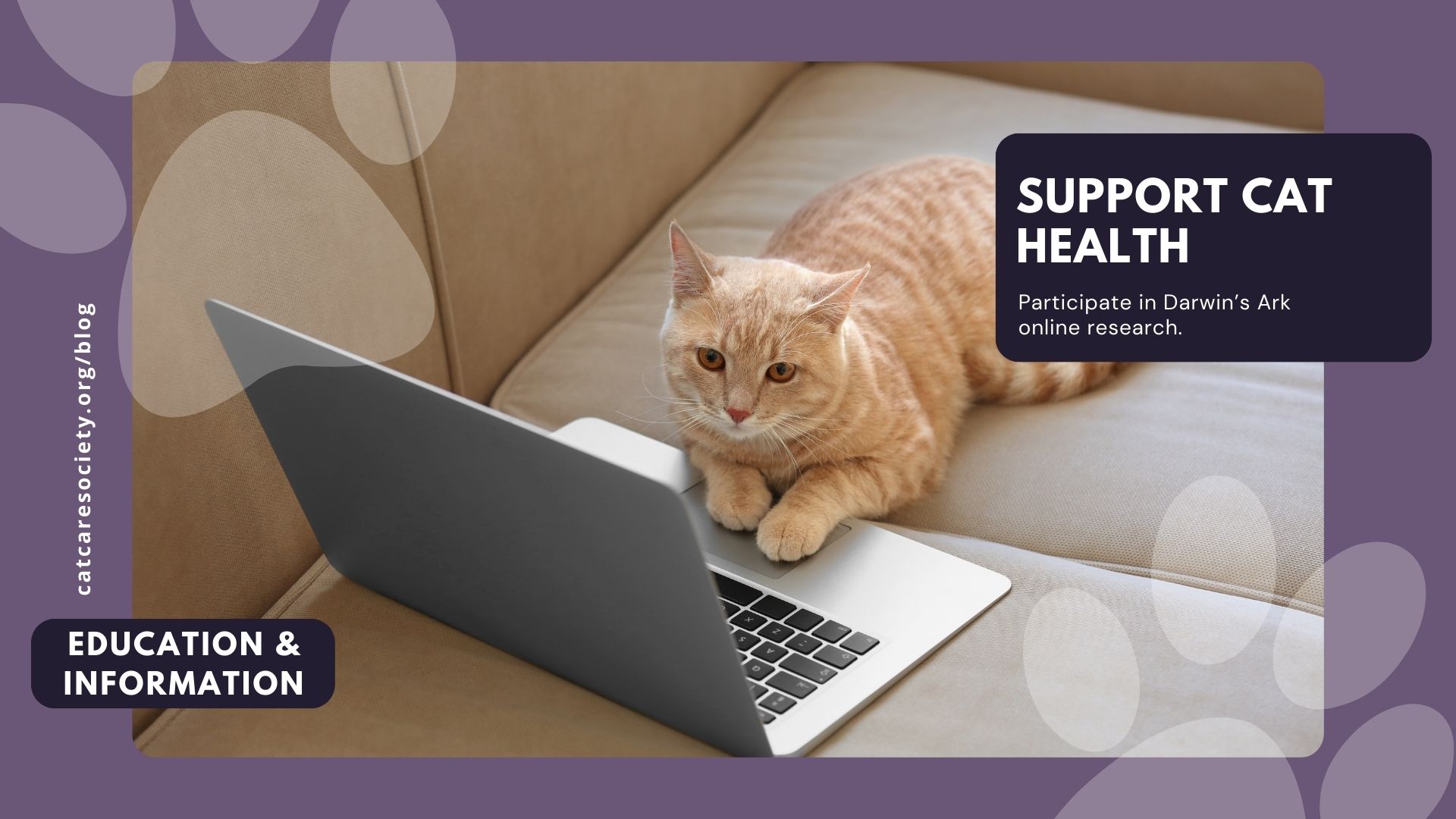
Let’s be honest—if you’re reading this, we probably don’t need to tell you how much joy cats bring into our lives. You already know the comfort of a purring cat in your lap, the entertainment of zoomies, and the simple calm of a cat sunbathing in a window. Cats are family.
But even though they’ve stolen our hearts (and our favorite spots on the couch), there’s still so much we don’t understand about their health. That’s where research comes in—and your participation can help in uncovering the mysteries behind feline wellness.
The health and wellbeing of cats often get overlooked in comparison to other pets like dogs. While research into canine health has flourished over the years, we’re only beginning to scratch the surface (pun intended) when it comes to understanding the unique needs and medical conditions of cats. From chronic illnesses like feline diabetes and kidney disease to behavioral issues such as anxiety and aggression, there are still many unanswered questions about what causes these conditions and how to best treat them.
To improve the lives of cats everywhere, we need more research. By deepening our understanding of how cats experience illness, aging, and stress, we can develop better treatments, prevention strategies, and care—helping them live longer, healthier, and happier lives.
One exciting initiative that aims to fill this gap in feline research is Darwin’s Ark, an online platform started by two pet lovers, a geneticist and an engineer, to advance scientific understanding of pet health. The website is an invaluable resource for anyone passionate about improving the lives of both dogs and cats through data-driven research.
For our purposes, we’re focusing on cat health, and at its core, Darwin’s Ark is about collecting and analyzing data from real cats living in homes, shelters, and other environments. The goal is to create a comprehensive database that researchers can use to study genetic and environmental factors that influence cat health. By gathering data on everything from a cat’s breed and genetic makeup to its medical history and behaviors, Darwin’s Ark provides vital insights that can shape future research.
The beauty of Darwin’s Ark is that it allows cat owners and shelters alike to play an active role in research. By participating in the program, you’re contributing valuable information that could lead to breakthroughs in veterinary science. Here’s how you can get involved:
The research conducted through Darwin’s Ark has the potential to change the way we think about feline health. By looking at the genetic and environmental factors that influence cats’ lives, researchers can gain a better understanding of how diseases like cancer, heart disease, and even infectious illnesses develop in cats. This information will help veterinarians make more accurate diagnoses, prescribe better treatments, and ultimately improve the lives of cats.
But it’s not just about medical conditions. Research into feline behavior and mental health is equally important. Many cats suffer from anxiety, depression, or stress, often due to changes in their environment, lack of stimulation, or inadequate socialization. By understanding the root causes of these behavioral issues, we can develop strategies to create happier, more well-adjusted cats who can thrive in their homes.
Additionally, shelters can use the findings from these studies to provide better care for cats in their care. Whether it’s understanding how to better treat sick cats, providing more enrichment opportunities, or improving the adoption process, data-driven research will help shelters give cats the best possible chance at a healthy and fulfilling life.
In the grand scheme of things, supporting research into feline health is about more than just helping individual cats—it’s about ensuring that all cats, everywhere, can live longer, healthier lives. The more we know, the better we can protect and care for our kitty companions, whether they’re our beloved pets at home or shelter cats.
For more information or to get started, visit Darwin’s Ark today and be sure to check out their fascinating blog article on why cats are so understudied. By supporting platforms like Darwin’s Ark, we take a step toward making a tangible difference in the lives of cats, promoting better health outcomes, and advancing our understanding of these extraordinary animals. Every small contribution counts—whether it’s participating in research, sharing the word, or making a donation. Let’s work together to ensure that all cats can live their best lives.
About the Author: Beth Dokolasa is a volunteer for Cat Care Society and serves on the Board of Directors. She is an instructional developer for Natural Grocers and lives in Indian Hills, Colo., with her husband, daughter, and two cats, Techno and Digit.
Please include your full name on a gift note when sending donations through Amazon or Chewy, so we can properly acknowledge your generous contribution! Without it, we won’t be able to identify that the items are from you. Also, please keep your shopping receipt, as it serves as your official donation receipt.
Copyright © 2024-2025 Cat Care Society. All Rights Reserved. | Privacy Policy
The Cat Care Society is a non-profit 501(c)(3) organization. Our tax identification number is 84-0869447.
Place your bids in our silent auction featuring cat-themed sculptures, paintings, pottery, and more!
Bidding will close Saturday, October 18, at approximately 7:30 PM.
The shelter will close at 3 PM today as we prepare for our Tails of the Painted Cats fundraising gala.
We apologize for any inconvenience. The shelter will reopen with normal hours on Sunday.
Upcoming events, special announcements, and cute cat photos delivered to your inbox bi-weekly!